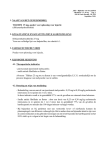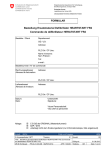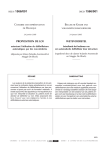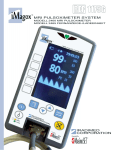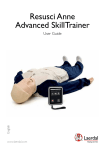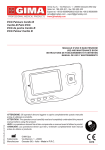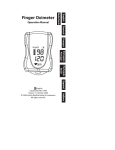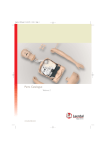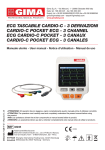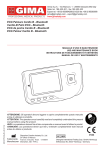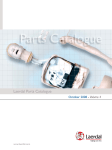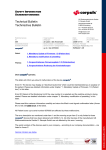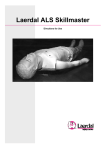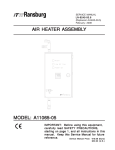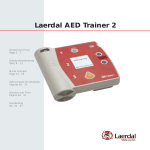Download HS 200 DfU 02-15EN.qxd
Transcript
HS 200 DfU 02-15EN.qxd
14.11.03
12:23
Page 17
®
Heartsim 200
– Directions for Use
Page 2 - 15
– Gebrauchsanweisung
Seite 16 - 29
– Mode d'emploi
Page 30 - 43
– Instrucciones de utilización
Páginas 44 - 57
– Istruzioni per l'Uso
Pagine 58 - 71
– Handleiding
Blz. 72 - 85
HS 200 DfU 02-15EN.qxd
12.11.03
13:25
Page 2
Contents
Limited Warranty ............................................ 2
Cautions and Warnings ................................
3
1. Introduction .............................................
4
2. Description ..............................................
4
3. Getting Started ........................................
3.1 Unpacking ........................................
3.2 Connecting the Heartsim 200 ..........
5
5
5
4. Operation ................................................ 6
4.1 General ............................................ 6
4.2 ECG Rhythms .................................. 7
4.3 Activation of a New Rhythm ............. 10
4.4 Ignore Shock Function .................... 11
4.5 Pulse Function ................................. 12
5. Maintenance ...........................................
5.1 Trouble Shooting .............................
5.2 Servicing .........................................
5.3 Cleaning ..........................................
13
13
13
13
6. Parts List ................................................. 14
7. Technical Data ....................................... 15
Limited Warranty
Laerdal warrants to the purchaser that its product(s) is/are free
from defects in material and workmanship for a period of one (1)
year from the date of purchase by the original user. During the
designated one (1) year period, Laerdal will, upon receipt of a
product found to be defective due to materials or workmanship
from the purchaser and notification in writing of the defect at its
option repair or replace any parts found to be defective or the
entire product.
Products found to be defective and notification of defects may also
be sent to the authorized Laerdal dealer from whom the product
was purchased. All postage, shipping, or handling charges shall be
the sole responsibility of the purchaser.
2
HS 200 DfU 02-15EN.qxd
12.11.03
13:25
Page 3
Laerdal is responsible for the effects of safety, reliability and
performance of its product(s) only if:
ENGLISH
– Service, repair, readjustment or modification is carried out by
Laerdal or persons authorized by Laerdal.
– The electrical installation of the room where the product is used
complies with pertinent national requirements.
– The product is used in the proper manner in strict compliance
with its Directions for Use.
Laerdal shall not be liable under this warranty for incidental or
consequential damages or in the event any unauthorized repairs or
modifications have been made or attempted or when the product,
or any part thereof, has been damaged by accident, misuse or
abuse. This warranty does not cover batteries, fuses, normal wear
and tear, staining, discoloration or other cosmetic irregularity which
does not impede or degrade product performance.
Some states in the USA do not allow the exclusion or limitation of
incidental or consequential damages, so those limitations or
exclusions may not apply to you.
There are no other express or implied warranties, whether of
merchantability, fitness or purpose, or otherwise, on the product, its
parts and accessories.
Cautions and Warnings
When using the Heartsim 200 together with a training manikin and
defibrillator, the warnings and cautions given in their respective
Directions for Use must be followed.
Do not open the Heartsim 200 case, there are no user serviceable
parts. Refer the unit to a qualified service technician.
This device generates, uses and can radiate radio frequency
energy. If it is not installed and used in accordance with the
instructions, it may cause harmful interference to radio
communications. In that case the user is encouraged to try to
correct the interference by:
- Reorienting or relocating the receiving antenna.
- Increasing the distance between the device and the receiver.
- Connecting the device into an outlet on a circuit different from
that to which the receiver is connected.
- Consulting the dealer or an experienced radio/TV technician
for help.
3
HS 200 DfU 02-15EN.qxd
12.11.03
13:25
Page 4
1.Introduction
The Heartsim 200 is a battery powered ECG rhythm simulator
which provides simulation of basic, modified and pediatric
rhythms with the applicable pulse rate and strength. Dedicated
controls and indicators for each function make the Heartsim 200
simple to use.
The Heartsim 200 has been designed to be used with the ALS
Skilltrainer and ALS Baby Trainer. However, by using the Heartsim
200 link cable (cat. No. 29 20 21) the following manikins can also
be used with the Heartsim 200, although no pulse is generated:
- Skillmeter Arrhythmia Trainer
- Early Defibrillation Trainer
- Basic ALS Trainer.
The Heartsim 200 can also be used as a stand-alone unit to provide
ECG signals for display on any standard 3-lead ECG monitor.
This Directions for Use provides all the information to fully utilise
the Heartsim 200 but does not aim to provide related medical
knowledge.
Note: The training manikins are supplied with their own
Directions for Use.
2.Description
The Heartsim 200 is a hand held unit with the function keys
incorporated on the top panel. Every key (with the exception of the
Paroxysmal and Change rhythm keys) has an associated LED to
indicate the status of its function. The unit connects to the manikin
by plugging the cable into the top end of the unit or via the ECG
mounts on the top of the control panel.
The rear of the unit contains the battery compartment.
4
HS 200 DfU 02-15EN.qxd
12.11.03
13:25
Page 5
3.Getting Started
ENGLISH
3.1 Unpacking
Remove the Heartsim 200 from its packaging.
If there is any obvious sign of damage, immediately notify
Laerdal Medical and the carrier. Remove the battery cover
and then remove the battery tag that is temporarily installed
to prevent discharge of the batteries.
3.2 Connecting the Heartsim 200
3.2.1 Connecting the Manikin
To connect the ALS Skilltrainer to the Heartsim 200, connect the
cable from the side of the manikin to the connector on the top end
of the Heartsim 200. This port also accepts the Heartsim 200 link
cable plug.
Note: The plug will only enter the receptacle
with the correct orientation.
3.2.2 Connecting the ALS Baby Trainer
Connect the manikin's three connectors onto the ECG mounts on
the top of the control panel. These mounts can also connect directly
to an ECG monitor for rhythm recognition training.
5
HS 200 DfU 02-15EN.qxd
12.11.03
13:25
Page 6
4.Operation
4.1 General
4.1.1 Power On/Off
To switch on the Heartsim 200, simply press the On/Off key.
To switch off the Heartsim 200, press the On/Off key a second time.
To conserve battery power, the Heartsim 200 automatically
switches off after approximately 10 minutes if there has been
no user activity.
6427 rev A
200
HEARTSI
HEARTSIM
M
®
Sinus
VTslow
VTfast
VFcoarse
VFfine
Asystole
Sin.Brad
Sin.Tach
Torsade
Atr.Flutt.
Atr.Fibr.
Atr.Tach
1°AVB
2°AVB#1
2°AVB#2
3°AVB
Junctional
Junc.Tach
Unif.PVC
Multif.PVC
Coupl.PVC
PAC
PJC
Sin.Tach
SVT
VT
INFANT RHYTHMS
Sinus
Sin.Brad
VF
Asystole
Battery low
ON/ Off
Ignore
shock
Pulse
Paroxysmal
Change
rhythm
normal
weak
absent
4.1.2 Battery Low Indication
The yellow Battery low LED switches on to indicate that battery
power is low and that the batteries should be replaced. See
section 5.2.1 for battery removal/replacement. The Heartsim 200
will operate after the battery low LED is lit, but when the battery
voltage is too low, the unit will switch automatically off.
Note: The amplitude of the ECG and pulse strength may be
affected when the Battery low LED is lit.
6
HS 200 DfU 02-15EN.qxd
12.11.03
13:25
Page 7
4.2 ECG Rhythms
ENGLISH
The ECG rhythms can be selected from their own dedicated
controls on the keyboard. Each rhythm has its own key and green
LED indicator that tells you which rhythm has been selected and
its status. The Heartsim 200 has keys for the following rhythms:
Basic Rhythms
Key Marking
Sinus
VT slow
VT fast
VF coarse
VF fine
Asystole
Rate
80
120
220
-
Descriptive Name
Normal Sinus Rhythm (NSR)
Ventricular Tachycardia, slow
Ventricular Tachycardia, fast
Ventricular Fibrillation, coarse
Ventricular Fibrillation, fine
Asystole.
6427 rev A
200
HEARTSI
HEARTSIM
M
®
Sinus
VTslow
VTfast
VFcoarse
VFfine
Asystole
Sin.Brad
Sin.Tach
Torsade
Atr.Flutt.
Atr.Fibr.
Atr.Tach
1°AVB
2°AVB#1
2°AVB#2
3°AVB
Junctional
Junc.Tach
Unif.PVC
Multif.PVC
Coupl.PVC
PAC
PJC
Sin.Tach
SVT
VT
INFANT RHYTHMS
Sinus
Sin.Brad
VF
Asystole
Battery low
ON/ Off
Ignore
shock
Pulse
Paroxysmal
Change
rhythm
normal
weak
absent
7
HS 200 DfU 02-15EN.qxd
12.11.03
13:25
Page 8
Modified Rhythms
Key Marking
Sin. Brad
Sin. Tach
Torsade
Atr. Flutt
Atr. Fibr
Atr. Tach
1°AVB
2°AVB #1
2°AVB #2
3°AVB
Junctional
Junc. Tach
Unif. PVC
Multif. PVC
Coupl. PVC
PAC
Rate
40
140
150
140
210
60
80, 4:3
80, 2:1/3:1
50
50
120
80
80
80
80
PJC
80
Descriptive Name
Sinus Bradycardia
Sinus Tachycardia
Torsade des Pointes
Atrial Flutter
Atrial Fibrillation
Atrial Tachycardia
1st Degr. AV Block
2nd Degr. AV Block #1
2nd Degr. AV Block #2
3rd Degr. AV Block
Junctional Rhythm
Junctional Tachycardia
NSR with Unifocal PVCs
NSR with Multifocal PVCs
Sinus with Coupled PVCs
Sinus with PACs
(Premature Atrial Complex)
Sinus with PJCs
(Premature Junctional Complex)
6427 rev A
200
HEARTSI
HEARTSIM
M
®
Sinus
VTslow
VTfast
VFcoarse
VFfine
Asystole
Sin.Brad
Sin.Tach
Torsade
Atr.Flutt.
Atr.Fibr.
Atr.Tach
1°AVB
2°AVB#1
2°AVB#2
3°AVB
Junctional
Junc.Tach
Unif.PVC
Multif.PVC
Coupl.PVC
PAC
PJC
Sin.Tach
SVT
VT
INFANT RHYTHMS
Sinus
Sin.Brad
VF
Asystole
Battery low
ON/ Off
Ignore
shock
Pulse
normal
weak
absent
8
Paroxysmal
Change
rhythm
HS 200 DfU 02-15EN.qxd
12.11.03
13:25
Page 9
Infant Rhythms
Rate
130
80
180
280
210
-
Descriptive Name
Normal Sinus Rhythm (NSR)
Sinus Bradycardia
Sinus Tachycardia
Supraventricular Tachycardia
Ventricular Tachycardia
Ventricular Fibrillation
Asystole
ENGLISH
Key Marking
Sinus
Sin. Brad
Sin. Tach
SVT
VT
VF
Asystole
6427 rev A
200
HEARTSI
HEARTSIM
M
®
Sinus
VTslow
VTfast
VFcoarse
VFfine
Asystole
Sin.Brad
Sin.Tach
Torsade
Atr.Flutt.
Atr.Fibr.
Atr.Tach
1°AVB
2°AVB#1
2°AVB#2
3°AVB
Junctional
Junc.Tach
Unif.PVC
Multif.PVC
Coupl.PVC
PAC
PJC
Sin.Tach
SVT
VT
INFANT RHYTHMS
Sinus
Sin.Brad
VF
Asystole
Battery low
ON/ Off
Ignore
shock
Pulse
Paroxysmal
Change
rhythm
normal
weak
absent
4.2.1 Running/Waiting Rhythm Indication
The green LED indicator next to the key shows you which
rhythm has been selected and its status. A flashing LED denotes
a waiting rhythm and a steady LED denotes a running rhythm.
4.2.2 Default Rhythm
The default running rhythm when you switch on the Heartsim 200
is the Normal Sinus Rhythm (NSR).
4.2.3 Selecting a New Rhythm
To select a new rhythm simply press the key of the new rhythm
you require. Your new selection is indicated as a waiting rhythm.
To activate, see next page.
9
HS 200 DfU 02-15EN.qxd
12.11.03
13:25
Page 10
4.3 Activation of a New Rhythm
There are three methods to activate a new rhythm:
4.3.1 Use the Change Rhythm Key
When you push the Change rhythm key the present selected
running rhythm is deactivated and the selected waiting rhythm
becomes the new running rhythm.
200
HEARTSI
HEARTSIM
M
®
Sinus
VTslow
VTfast
VFcoarse
VFfine
Asystole
Sin.Brad
Sin.Tach
Torsade
Atr.Flutt.
Atr.Fibr.
Atr.Tach
1°AVB
2°AVB#1
2°AVB#2
3°AVB
Junctional
Junc.Tach
Unif.PVC
Multif.PVC
Coupl.PVC
PAC
PJC
Sin.Tach
SVT
VT
INFANT RHYTHMS
Sinus
Sin.Brad
VF
Asystole
Battery low
ON/ Off
Ignore
shock
Pulse
Paroxysmal
Change
rhythm
normal
weak
absent
4.3.2 Defibrillation of the Manikin
Defibrillation of the manikin deactivates the selected running
rhythm and the selected waiting rhythm becomes the new running
rhythm, unless the Ignore Shock button is on.
4.3.3 Paroxysmal Function
When you push the Paroxysmal Function key you can alternate
between a running rhythm and a waiting rhythm.
10
HS 200 DfU 02-15EN.qxd
12.11.03
13:25
Page 11
4.4 Ignore Shock Function
ENGLISH
When you push the Ignore shock key, the detection of the shock
is ignored and the status of the ECG rhythm stays the same. This
function is engaged until you push the Ignore shock key again.
6427 rev A
200
HEARTSI
HEARTSIM
M
®
Sinus
VTslow
VTfast
VFcoarse
VFfine
Asystole
Sin.Brad
Sin.Tach
Torsade
Atr.Flutt.
Atr.Fibr.
Atr.Tach
1°AVB
2°AVB#1
2°AVB#2
3°AVB
Junctional
Junc.Tach
Unif.PVC
Multif.PVC
Coupl.PVC
PAC
PJC
Sin.Tach
SVT
VT
INFANT RHYTHMS
Sinus
Sin.Brad
VF
Asystole
Battery low
ON/ Off
Ignore
shock
Pulse
Paroxysmal
Change
rhythm
normal
weak
absent
11
HS 200 DfU 02-15EN.qxd
12.11.03
13:25
Page 12
4.5 Pulse Function
4.5.1 Default Pulse Strength
The default pulse strength when you switch on the Heartsim 200 is
Normal. Since the default rythm is NSR, the pulse strength that will
be felt on the manikin will be similar to the normal pulse on a
healthy individual.
4.5.2 Pulse Strength Selection
You can select three different pulse strengths:
- Normal
- Weak
- Absent.
A single push of the Pulse key changes the pulse strength
selection from the default strength (Normal) to Absent. The next
push changes the pulse strength to Weak, and the next returns it
to Normal. Further pushes of the Pulse key change the selection
sequentially. The pulse rates simulated in the Normal and Weak
settings will depend upon selected rhythm.
4.5.3 Indication
Each pulse strength has its own green LED that comes on to show
you which pulse strength has been selected.
6427 rev A
200
HEARTSI
HEARTSIM
M
®
Sinus
VTslow
VTfast
VFcoarse
VFfine
Asystole
Sin.Brad
Sin.Tach
Torsade
Atr.Flutt.
Atr.Fibr.
Atr.Tach
1°AVB
2°AVB#1
2°AVB#2
3°AVB
Junctional
Junc.Tach
Unif.PVC
Multif.PVC
Coupl.PVC
PAC
PJC
Sin.Tach
SVT
VT
INFANT RHYTHMS
Sinus
Sin.Brad
VF
Asystole
Battery low
ON/ Off
Ignore
shock
Pulse
normal
weak
absent
Note: The ALS Baby Trainer has a manually operated pulse.
12
Paroxysmal
Change
rhythm
HS 200 DfU 02-15EN.qxd
12.11.03
13:25
Page 13
5.Maintenance
5.1 Trouble Shooting
Problem
Correction
Battery Low LED is on
- Replace batteries
No ECG signals displayed
- Check all connections
No pulse simulation
- Check to see if battery
low LED is on.
- Check manikin cable
connection.
- Check type of manikin
(see page 4).
- ALS Skilltrainer only:
Pulse is pressed down on
both sides simultaneously.
ENGLISH
The Heartsim 200 is designed to be a reliable unit requiring a
minimum of maintenance. With this in mind, there are only a few
faults the user can rectify. In all other cases contact Laerdal
Medical, or your Laerdal dealer for authorized servicing or repair.
5.2 Servicing
5.2.1 Battery Removal/Replacement
To remove and replace the batteries:
- Remove the battery cover on the rear of the Heartsim 200.
- Remove and safely discard the old batteries.
- Install the new batteries, AA size (R6) 1.5V, in the correct
orientation as shown on the cabinet bottom.
- Re-fit the battery cover.
5.3 Cleaning
5.3.1 General
Cleaning of the Heartsim 200 is restricted to general cleaning of
the keyboard and case:
- Moisten a cloth with a suitable cleaning agent. Use a mild soap
or cleaner.
- Gently wipe the surface of the keyboard and case.
- Remove any excess liquid with a dry cloth.
- Do not immerse the unit in water.
13
HS 200 DfU 02-15EN.qxd
12.11.03
13:25
Page 14
6.Parts List
26 00 10
26 10 00
26 10 20
26 04 20
Heartsim 200
Soft pack
Battery case lid
Directions for use Heartsim 200
Extra Equipment
29 20 21
Heartsim 200 link cable
If increased battery life is needed, there is an extra battery pack
available which is mounted in ALS Skilltrainer.
See ALS Skilltrainer Directions for Use.
Product specifications are subject to change without notice.
14
HS 200 DfU 02-15EN.qxd
12.11.03
13:25
Page 15
7.Technical Data
Power Supplies
- Power supply
- Batteries
- Number of batteries
- Capacity
- Battery life time
10°C to 40°C
15 to 90% RH (non - condensing)
70 kPa to 106 kPa
- Battery low indicator operation
9V from internal batteries
AA size (R6) 1.5V
6
2500 mAh
Approx. 12.5 hours until the
unit switches automatically off.
This is under the following
conditions:
Normal Sinus Rhythm
Pulse active max. 10 sec./min.
20°C
6.6 +/- 0.2 VDC
Storage
- Temperature
- Humidity
- 15 to + 50°C
15 to 90% RH (non - condensing)
Physical Dimensions
- Size
- Weight incl. batteries
233 x 132 x 63 mm
0.5 kg
ENGLISH
Environmental Data
- Temperature
- Humidity
- Atmospheric pressure
Symbols used
Type B in accordance with IEC-601.
Standards/Approvals
The product is in compliance with essential requirements
of council directive 89 / 366 / EEC; EMC - directive.
Limit B of EN 55011/1991 (CISPR 11/1990)
Limit B of VDE 0871 / 6.78 with amendments of Amtsblatt
no 163 / 1984 Vfg. 1046
Limit B of FCC rules and regulations part 15, subpart B.
EN 50082 -1 / 1992 (IEC 801-2, -3, -4).
IEC 601-1
15
HS 200 DfU 16-29GE.qxd
12.11.03
13:28
Page 16
Inhalt
Garantie ........................................................ 17
Sicherheitshinweise ...................................... 17
1. Einleitung ................................................ 18
2. Beschreibung ......................................... 18
3. Vorbereitung zur Inbetriebnahme .......... 19
3.1 Auspacken ........................................ 19
3.2 Anschlüsse ....................................... 19
4. Bedienung ..............................................
4.1 Allgemeines ......................................
4.2 EKG Rhythmen ................................
4.3 EKG-Rhythmus aktivieren .................
4.4 Funktion "Schock ignorieren" ............
4.5 Puls ....................................................
20
20
21
24
25
26
5. Wartung ...................................................
5.1 Fehlerbehebung ...............................
5.2 Service ..............................................
5.3 Reinigung ..........................................
27
27
27
27
6. Teileliste .................................................. 28
7. Technische Daten .................................. 29
16
HS 200 DfU 16-29GE.qxd
12.11.03
13:28
Page 17
Garantie
Die Gewährleistungsfrist beträgt 12 Monate und beginnt mit dem
Datum der Lieferung. Die Haftung gilt nicht für normale Abnutzung,
Batterien und Sicherungen.
Laerdal betrachtet sich nur dann für die Auswirkungen auf
Sicherheit, Zuverlässigkeit und Leistung des Gerätes als verantwortlich, wenn:
–
–
–
–
Montage
Erweiterungen
Neueinstellungen
Änderungen
– Reparaturen
– Wartung
DEUTSCH
nur von Laerdal oder von Laerdal autorisierten Personen ausgeführt
werden und das Gerät in Übereinstimmung mit der Gebrauchsanweisung verwendet wird. Desweiteren gelten unsere "Allgemeinen
Geschäftsbedingungen" ( siehe dort § 6, Gewährleistung und Haftung).
Sicherheitshinweise
Beim Gebrauch von Heartsim 200 zusammen mit einer Übungspuppe und einem Defibrillator sind die Sicherheitshinweise und
Vorsichtsmaßnahmen in den entsprechenden Gebrauchsanweisungen dieser Geräte zu beachten.
Öffnen Sie Heartsim 200 nicht. Erforderliche Reparaturen können
nur von Laerdal oder von Laerdal autorisierten Personen durchgeführt werden.
Dieses Gerät erzeugt und arbeitet mit Radiofrequenzen. Wenn es
nicht entsprechend der Gebrauchsanweisung verwendet wird,
kann es zu Interferenzstörungen in Kommunikationsanlagen führen.
In diesen Fällen beachten Sie bitte:
- Empfangsantennen entsprechend ausrichten bzw. aufstellen.
- Abstand zwischen Heartsim 200 und Empfangsanlage
vergrößern.
- Im Zweifelsfalle kontaktieren Sie einen Radio-/Fernsehtechniker.
17
HS 200 DfU 16-29GE.qxd
12.11.03
13:28
Page 18
1.Einleitung
Heartsim 200 ist ein batteriebetriebener EKG-Rhythmus-Simulator,
mit dem Basisrhythmen mit deren Modifikationen sowie pädiatrische Rhythmen mit entsprechenden Pulsfrequenzen simuliert
werden können. Übersichtliche Bedien - und Anzeigeelemente
machen die Bedienung von Heartsim 200 sehr einfach.
Heartsim 200 ist vorgesehen zur Verwendung mit Megacode
Trainer Standard und Megacode Baby. Mit einem speziellen
Verbindungskabel, Kat.-Nr. 29 20 21, kann Heartsim 200 auch
mit den nachfolgend aufgeführten Übungsgeräten verwendet
werden, jedoch ohne Pulssimulation:
- Skillmeter Arrhythmia Trainer
- Frühdefibrillations-Trainer
- Megacode Trainer Basis
Heartsim 200 kann auch alleine als EKG-Simulator zur Darstellung
von EKG-Rhythmen auf jedem Standard-EKG-Monitor (3 Ableitungen) verwendet werden.
Diese Gebrauchsanweisung enthält Informationen, um alle
Möglichkeiten von Heartsim 200 optimal nutzen zu können. Sie ist
jedoch kein Lehrmittel zur Vermittlung von medizinischem Wissen.
Anmerkung: Die Übungspuppen selbst sind mit deren
Gebrauchsanweisungen ausgestattet.
2.Beschreibung
Heartsim 200 ist ein handliches Gerät, die Bedien- und Anzeigeelemente befinden sich auf der Oberseite des Gerätes. Jedem
Taster ist eine LED (Leuchtdiode) zugeordnet (außer paroxysmaler Rhythmus und Rhythmuswechsel), die den Status der
entsprechenden Funktion anzeigt. Der Anschluß für das Verbindungskabel zur Übungspuppe befindet sich am oberen Ende
des Gerätes, die Anschlüsse zu einem EKG-Monitor befinden sich
am oberen Ende der Frontplatte. An der Unterseite des Gerätes
befindet sich der Batterieschacht.
18
HS 200 DfU 16-29GE.qxd
12.11.03
13:28
Page 19
3.Vorbereiten zur Inbetriebnahme
3.1 Auspacken
Heartsim 200 der Verpackung entnehmen. Sollten Sie
Beschädigungen feststellen, wenden Sie sich bitte sofort an
Laerdal. Batteriedeckel an der Geräteunterseite abnehmen
und Isolierstreifen entnehmen.
DEUTSCH
3.2 Heartsim 200 anschließen
3.2.1 Übungspuppe anschließen
Kabel vom Megacode-Trainer Standard am oberen Ende des Gerätes
anschließen. An diesem Anschluß kann auch das Verbindungskabel
29 20 21 angeschlossen werden.
Anmerkung: Achten Sie bitte auf korrekte Ausrichtung
des Steckers.
3.2.2 Megacode Trainer Baby anschließen
Das 3-polige Kabel der Übungspuppe wird an den oberen Druckknopfanschlüssen angeschlossen, ebenso 3-polige Standard EKGKabel zu einem EKG-Monitor.
19
HS 200 DfU 16-29GE.qxd
12.11.03
13:28
Page 20
4.Bedienung
4.1 Allgemeines
4.1.1 Ein-/Ausschalten (ON/OFF)
Zum Einschalten ON/OFF-Taste drücken. Zum Ausschalten die
ON/OFF-Taste erneut drücken.
Um die Batterien zu schonen, schaltet das Gerät automatisch
nach ca. 10 Minuten ab, wenn innerhalb dieser Zeit keine
Aktivitäten erfolgen.
6427 rev A
200
HEARTSI
HEARTSIM
M
®
Sinus
VTslow
VTfast
VFcoarse
VFfine
Asystole
Sin.Brad
Sin.Tach
Torsade
Atr.Flutt.
Atr.Fibr.
Atr.Tach
1°AVB
2°AVB#1
2°AVB#2
3°AVB
Junctional
Junc.Tach
Unif.PVC
Multif.PVC
Coupl.PVC
PAC
PJC
Sin.Tach
SVT
VT
INFANT RHYTHMS
Sinus
Sin.Brad
VF
Asystole
Battery low
ON/ Off
Ignore
shock
Pulse
Paroxysmal
Change
rhythm
normal
weak
absent
4.1.2 Batterie schwach - Anzeige
Die gelbe Batterie schwach - LED zeigt an, daß die Batteriekapazität zu niedrig ist und ein Batteriewechsel erforderlich ist.
Siehe Abschnitt 5.2.1 für Batteriewechsel. Heartsim 200 arbeitet
zwar noch nach dem ersten Aufleuchten der Batterie schwach LED, wenn jedoch die Batteriespannung zu niedrig wird,
schaltet das Gerät ab.
Anmerkung: Die EKG-Amplitude sowie die Pulsfunktion kann beeinträchtigt werden, wenn die Batterie schwach LED aufleuchtet.
20
HS 200 DfU 16-29GE.qxd
12.11.03
13:28
Page 21
4.2 EKG Rhythmen
Die verschiedenen EKG Rhythmen können durch Tastendruck
ausgewählt werden. Für jeden EKG Rhythmus ist eine spezielle
Taste und eine grüne LED vorhanden. Am Heartsim 200 können
folgende Rhythmen eingestellt werden:
Basisrhythmen
Frequenz
80
120
220
-
Bezeichnung
normaler Sinusrhythmus (NSR)
langsame Kammertachykardie
schnelle Kammertachykardie
grobes Kammerflimmern
feines Kammerflimmern
Asystolie
6427 rev A
DEUTSCH
Taste
Sinus
VT slow
VT fast
VF coarse
VF fine
Asystole
200
HEARTSI
HEARTSIM
M
®
Sinus
VTslow
VTfast
VFcoarse
VFfine
Asystole
Sin.Brad
Sin.Tach
Torsade
Atr.Flutt.
Atr.Fibr.
Atr.Tach
1°AVB
2°AVB#1
2°AVB#2
3°AVB
Junctional
Junc.Tach
Unif.PVC
Multif.PVC
Coupl.PVC
PAC
PJC
Sin.Tach
SVT
VT
INFANT RHYTHMS
Sinus
Sin.Brad
VF
Asystole
Battery low
ON/ Off
Ignore
shock
Pulse
Paroxysmal
Change
rhythm
normal
weak
absent
21
HS 200 DfU 16-29GE.qxd
12.11.03
13:28
Page 22
Modifizierte Rhythmen
Taste
Sin. Brad
Sin. Tach
Torsade
Atr. Flutt
Atr. Fibr
Atr. Tach
1° AVB
2° AVB #1
2° AVB #2
3° AVB
Junctional
Junc. Tach
Unif. PVC
Multif. PVC
Coupl. PVC
PAC
Frequenz
40
140
150
140
210
60
80, 4:3
80, 2:1/3:1
50
50
120
80
80
80
80
PJC
80
Bezeichnung
Sinusbradykardie
Sinustachykardie
Torsade des Pointes
Vorhofflattern
Vorhofflimmern
Vorhoftachykardie
AV Block 1°
AV Block 2° (Wenckebach)
AV Block 2°
AV Block 3°
Knotenrhythmus
Knotentachykardie
NSR mit unifokalen VES
NSR mit multifokalen VES
Sinusrhythmus mit Couplets
Sinusrhythmus mit
Vorhofextrasystolen
Sinusrhythmus mit
Knotenextrasystolen
6427 rev A
200
HEARTSI
HEARTSIM
M
®
Sinus
VTslow
VTfast
VFcoarse
VFfine
Asystole
Sin.Brad
Sin.Tach
Torsade
Atr.Flutt.
Atr.Fibr.
Atr.Tach
1°AVB
2°AVB#1
2°AVB#2
3°AVB
Junctional
Junc.Tach
Unif.PVC
Multif.PVC
Coupl.PVC
PAC
PJC
Sin.Tach
SVT
VT
INFANT RHYTHMS
Sinus
Sin.Brad
VF
Asystole
Battery low
ON/ Off
Ignore
shock
Pulse
normal
weak
absent
22
Paroxysmal
Change
rhythm
HS 200 DfU 16-29GE.qxd
12.11.03
13:28
Page 23
Pädiatrische Rhythmen
Frequenz
130
80
180
280
210
-
Bezeichnung
Normaler Sinusrhythmus (NSR)
Sinusbradykardie
Sinustachykardie
Supraventrikuläre Tachykardie
Kammertachykardie
Kammerflimmern
Asystolie
6427 rev A
200
HEARTSI
HEARTSIM
M
®
Sinus
VTslow
VTfast
VFcoarse
VFfine
Asystole
Sin.Brad
Sin.Tach
Torsade
Atr.Flutt.
Atr.Fibr.
Atr.Tach
1°AVB
2°AVB#1
2°AVB#2
3°AVB
Junctional
Junc.Tach
Unif.PVC
Multif.PVC
Coupl.PVC
PAC
PJC
Sin.Tach
SVT
VT
DEUTSCH
Taste
Sinus
Sin. Brad
Sin. Tach
SVT
VT
VF
Asystole
INFANT RHYTHMS
Sinus
Sin.Brad
VF
Asystole
Battery low
ON/ Off
Ignore
shock
Pulse
Paroxysmal
Change
rhythm
normal
weak
absent
4.2.1 LED Anzeige (Aktueller-/ Warterhythmus Anzeige)
Die grüne LED neben einer Taste zeigt, welcher Rhythmus
gewählt wurde. LED Blinklicht = Warterhythmus.
LED Dauerlicht = Aktueller Rhythmus.
4.2.2 Grundeinstellung
Beim Einschalten von Heartsim 200 ist immer ein NSR als
aktueller Rhythmus eingestellt.
4.2.3 Rhythmusauswahl
Um einen neuen Rhythmus auszuwählen, betätigen Sie die
entsprechend bezeichnete Taste. Nach Tastendruck beginnt die
grüne LED zu blinken und markiert den vorgewählten Rhythmus
als Warterhythmus.
23
HS 200 DfU 16-29GE.qxd
12.11.03
13:28
Page 24
4.3 EKG-Rhythmus aktivieren
Es gibt drei Möglichkeiten, einen vorgewählten Rhythmus
(LED Blinklicht) zu aktivieren:
4.3.1 "Change Rhythm" Taste
Durch Betätigen der "Change Rhythm" Taste wird der gerade
laufende Rhythmus deaktiviert und ein vorgewählter Warterhythmus aktiviert.
200
HEARTSI
HEARTSIM
M
®
Sinus
VTslow
VTfast
VFcoarse
VFfine
Asystole
Sin.Brad
Sin.Tach
Torsade
Atr.Flutt.
Atr.Fibr.
Atr.Tach
1°AVB
2°AVB#1
2°AVB#2
3°AVB
Junctional
Junc.Tach
Unif.PVC
Multif.PVC
Coupl.PVC
PAC
PJC
Sin.Tach
SVT
VT
INFANT RHYTHMS
Sinus
Sin.Brad
VF
Asystole
Battery low
ON/ Off
Ignore
shock
Pulse
Paroxysmal
Change
rhythm
normal
weak
absent
4.3.2 Defibrillation
Durch eine Defibrillation des Übungsmodelles wird der gerade
laufende Rhythmus deaktiviert und ein vorgewählter Warterhythmus aktiviert. Ist zum Zeitpunkt der Defibrillation die Funktion
"Ignore Schock" aktiv, unterbleibt die Umschaltung der Rhythmen.
4.3.3 "Paroxysmal" Funktion
Durch Betätigen der Paroxysmal Taste kann zwischen zwei vorgewählten Rhythmen ( Laufender Rhythmus und Warterhythmus)
hin und her geschaltet werden.
24
HS 200 DfU 16-29GE.qxd
12.11.03
13:28
Page 25
4.4 Funktion "Schock ignorieren"
Wird die "Ignore Schock" Taste gedrückt, führt eine auf das
Übungsmodell abgegebene Defibrillation nicht zu einer
Umschaltung des Rhythmus. Die Funktion muß durch erneuten
Tastendruck aufgehoben werden.
®
Sinus
VTslow
VTfast
VFcoarse
VFfine
Asystole
Sin.Brad
Sin.Tach
Torsade
Atr.Flutt.
Atr.Fibr.
Atr.Tach
1°AVB
2°AVB#1
2°AVB#2
3°AVB
Junctional
Junc.Tach
Unif.PVC
Multif.PVC
Coupl.PVC
PAC
PJC
Sin.Tach
SVT
VT
DEUTSCH
6427 rev A
200
HEARTSI
HEARTSIM
M
INFANT RHYTHMS
Sinus
Sin.Brad
VF
Asystole
Battery low
ON/ Off
Ignore
shock
Pulse
Paroxysmal
Change
rhythm
normal
weak
absent
25
HS 200 DfU 16-29GE.qxd
12.11.03
13:28
Page 26
4.5 Puls
4.5.1 Grundeinstellung der Pulsqualität
Die Pulsqualität am Übungsmodell nach dem Einschalten des
Heartsim 200 ist "Normal", d.h. die Pulsqualität entspricht der
eines normalen, gesunden Erwachsenen.
4.5.2 Pulsqualität
Folgende Einstellungen können gewählt werden:
- Normal = Normal (gut tastbar)
- Weak = Schwach (schwer tastbar)
- Absent = Pulslos
Ausgehend von der Grundeinstellung "Normal" wird durch einmaligen Tastendruck auf "Absent" (Pulslos) umgestellt. Ein zweiter
Tastendruck stellt auf "Weak" (Schwach), der dritte Tastendruck
wieder auf "Normal" um. Die Pulsqualität hängt auch vom
gewählten EKG Rhythmus ab.
4.5.3 LED
Die eingestellte Pulsqualität wird durch Dauerlicht der entsprechenden LED angezeigt.
6427 rev A
200
HEARTSI
HEARTSIM
M
®
Sinus
VTslow
VTfast
VFcoarse
VFfine
Asystole
Sin.Brad
Sin.Tach
Torsade
Atr.Flutt.
Atr.Fibr.
Atr.Tach
1°AVB
2°AVB#1
2°AVB#2
3°AVB
Junctional
Junc.Tach
Unif.PVC
Multif.PVC
Coupl.PVC
PAC
PJC
Sin.Tach
SVT
VT
INFANT RHYTHMS
Sinus
Sin.Brad
VF
Asystole
Battery low
ON/ Off
Ignore
shock
Pulse
normal
weak
absent
Hinweis: Das Megacode Baby hat keinen Pulsgenerator.
Daher muß der Puls manuell simuliert werden.
26
Paroxysmal
Change
rhythm
HS 200 DfU 16-29GE.qxd
12.11.03
13:28
Page 27
5. Wartung
5.1 Fehlerbehebung
Problem
Behebung
Batterie schwach LED leuchtet
- Batterien erneuern
Keine EKG-Signale
- Alle Anschlüsse überprüfen
Keine Pulssimulation
- Sicherstellen, daß Batterie
schwach LED nicht leuchtet
- Kabel zur Übungspuppe
überprüfen
- Puppentyp prüfen (siehe Seite 4)
- Nur Megacode Trainer Standard:
Puls wird gleichzeitig beidseits
gefühlt.
DEUTSCH
Die moderne Technik von Heartsim 200 macht diesen zu einem
zuverlässigen Gerät, welches ein Minimum an Wartung erfordert.
Aufgrund dessen gibt es auch nur einige wenige Probleme,
die der Anwender selbst beheben kann. In allen anderen Fällen
kontaktieren Sie bitte Laerdal oder deren autorisierte Partner.
5.2 Service
5.2.1 Batteriewechsel
- Batteriedeckel an der Geräteunterseite abnehmen.
- Batterien entnehmen und entsprechend entsorgen.
- Neue Batterien ( Typ AA/R6, 1,5V ) wie im Batteriekasten
angezeigt einsetzen (auf Polung achten!).
- Batteriedeckel wieder aufsetzen.
5.3 Reinigung
5.3.1 Allgemeines
Die Reinigung von Heartsim 200 beschränkt sich auf das Reinigen
des Tastenfeldes und des Gehäuses:
- Ein Tuch mit Seifenwasser oder einem milden Reiniger befeuchten.
- Vorsichtig das Tastenfeld und das Gehäuse abwischen.
- Überschüssige Flüssigkeit sofort mit einem trockenen Tuch
aufnehmen.
- Gerät nicht in Flüssigkeit eintauchen.
27
HS 200 DfU 16-29GE.qxd
12.11.03
13:28
Page 28
6.Teileliste
26 00 10
26 10 00
26 10 20
26 04 20
Heartsim 200
Softpack
Batteriefachdeckel
Gebrauchsanweisung Heartsim 200
Sonderzubehör
29 20 21
Verbindungskabel
Für erhöhte Anforderungen ist ein zusätzlicher Batterie-Pack zum
Einbau in den Megacode Trainer Standard erhältlich. Siehe hierzu
Gebrauchsanweisung Megacode Trainer Standard.
Laerdal betreibt eine kontinuierliche Produktentwicklung.
Änderungen der Spezifikationen sind somit möglich und bedürfen
keiner besonderen Ankündigung.
28
HS 200 DfU 16-29GE.qxd
12.11.03
13:28
Page 29
7.Technische Daten
Umgebungsbedingungen
- Luftdruck
Lagerung
- Temperaturbereich
- Luftfeuchtigkeit
Stromversorgung
- Stromversorgung
- Batterietyp
- Kapazität
- Batterielebensdauer
10°C bis 40°C
15 - 90% rel. Luftfeuchte,
nicht kondensierend
70 kPa - 106 kPa
-15°C bis +50°C
15 - 90% rel. Luftfeuchte,
nicht kondensierend
- Batterie schwach-Anzeige
9V über interne Batterien
6 Mignon AA /R6 1,5V
2500 mAh
Ca. 12,5 h bis das Gerät
selbsttätig abschaltet unter
folgenden Bedingungen:
Normaler Sinus-Rhythmus,
Puls aktiv max. 10 sec/min., 20°C
6,6V +/- 0,2V
Abmessungen
- Abmessungen
- Gewicht inkl. Batterien
233 mm x 132 mm x 63mm
0,5 kg
DEUTSCH
Betrieb
- Temperaturbereich
- Luftfeuchtigkeit
Verwendete Symbole
Klasse B entsprechend IEC 601.
Standards/Prüfungen
Dieses Gerät stimmt mit den grundlegenden Sicherheitsanforderungen
der EG- Richtlinien 89/366/EEC, (EMV), überein.
Abschnitt B EN 55011/1991 (CISPR 11/1990)
Abschnitt B VDE 0871/6.78 mit Ergänzung Amtsblatt Nr. 163/1984 Vfg. 1046
Abschnitt B FCC Teil 15, Unterteil B
EN 50082-1/1992 (IEC 801-2,-3,-4)
IEC 601-1
29
HS 200 DfU 30-43DU.qxd
12.11.03
13:31
Page 30
Inhoud
Beperkte Waarborgsbepalingen ................... 30
Waarschuwingen en voorzorgsmaatregelen 31
1. Inleiding .................................................. 32
2. Beschrijving ............................................. 32
3. Opstarten ............................................... 33
3.1 Uitpakken ..................................... 33
3.2 Aansluiten van de Heartsim 200 .... 33
4. Werking ..................................................
4.1 Algemeen........................................
4.2 ECG ritmes......................................
4.3 Aktivatie nieuw ritme........................
4.4 Negeer Schok Functie ...................
4.5 Pols-functie......................................
34
34
35
38
39
40
5. Onderhoud ..............................................
5.1 Oplossen van problemen ...............
5.2 Onderhoud......................................
5.3 Schoonmaken .................................
41
41
41
41
6. Onderdelenlijst ........................................ 42
7. Technische gegevens ............................. 43
Beperkte Waarborgbepalingen
Laerdal garandeert de koper dat het(de) produkt(en) vrij is(zijn) van
defecten door materiaal of fabricage voor een periode van één(1) jaar, te
rekenen vanaf de datum van de oorspronkelijke aankoop.Indien de koper
Laerdal binnen de aangegeven periode van één(1) jaar schriftelijk op de
hoogte brengt van een defect in materiaal of fabricage, zal Laerdal alle
onderdelen die defect werden bevonden repareren of vervangen (naar
eigen keuze), ofwel het produkt in zijn geheel vervangen.
Defecte produkten en de omschrijving van het defect mogen ook gestuurd
worden naar de gemachtigde Laerdal verdeler bij wie het produkt gekocht
werd.Alle kosten wat betreft port, versturing of verwerking zijn volledig voor
de verantwoordelijkheid van de koper.
Laerdal is verantwoordelijk voor de veiligheid, de betrouwbaarheid en de
prestaties van zijn produkt(en) enkel en alleen indien:
– Service, herstellingen, aanpassingen of wijzigingen aangebracht aan het
toestel werden uitgevoerd door Laerdal Medical of personen door haar
hiertoe gemachtigd.
30
HS 200 DfU 30-43DU.qxd
12.11.03
13:31
Page 31
–
De elektrische uitrusting in de kamer waar het produkt gebruikt
werd, in overeenstemming was met de essentiële nationale vereisten.
–
Op de juiste manier met het produkt omgegaan werd in strikte
overeenstemming met de gebruikershandleiding.
Onder deze waarborg stelt Laerdal zich niet verantwoordelijk voor
incidentele of gevolgde schade in geval van ongemachtigde herstellingen
of wijzigingen of pogingen hiertoe, alsook wanneer het toestel of eender
welk onderdeel hiervan beschadigd werd door een ongeval, slecht gebruik
of misbruik.Uitgesloten van deze aansprakelijkheid zijn batterijen, lampjes,
zekeringen, normale slijtage, vlekken, verkleuringen of andere cosmetische
onregelmatigheden die de functie van het apparaat niet belemmeren of
verminderen.
Sommige staten in de USA staan het uitsluiten van incidentele of consequente beschadigingen niet toe, dus deze beperkingen of uitsluitingen
behoeven niet van toepassing te zijn op uw vordering.
Er zijn geen andere uitdrukkelijke of ingesloten aansprakelijkheidsbepalingen, noch betreffende verkoopbaarheid of geschiktheid voor het
toestel m.b.t. doeleinde of andere zaken, noch betreffende onderdelen
of accessoires.
Waarschuwingen en voorzorgsmaatregelen
NEDERLANDS
Bij gebruik van de Heartsim 200 in combinatie met een oefenpop en een
defibrillator, moeten de voorzorgsmaatregelen en waarschuwingen uit de
respectievelijke gebruikershandleidingen nageleefd worden.
Open het huis van de Heartsim 200 niet, hierin zitten immers geen bruikbare
elementen.Verwijs de eenheid naar een bekwaam onderhoudstechnieker.
Dit toestel produceert en gebruikt energie onder de vorm van radiogolven,
hetgeen het ook kan uitstralen.Indien het toestel niet geplaatst en gebruikt
wordt zoals aangegeven in de handleiding, kan het schadelijke interacties
met radiocommunicaties veroorzaken.In dit geval wordt de gebruiker
aangemoedigd deze storingen te corrigeren door:
–
–
–
–
De ontvangstantenne te herplaatsen of te heroriënteren.
De afstand tussen het toestel en de ontvanger te vergroten.
Het toestel op een uitgang van een ander net aan te schakelen, dan
dat waarop de ontvanger is aangeschakeld.
De verdeler of een ervaren radio/TV technieker om hulp te vragen.
31
HS 200 DfU 30-43DU.qxd
12.11.03
13:31
Page 32
1. Inleidning
De Heartsim 200 is een hartritmesimulator op batterijen die voorziet
in de simulatie van basis-, gewijzigde en pediatrische ritmes en de
polssnelheid-en sterkte die hierbij van toepassing
zijn.Controlefuncties en indicators, specifiek voor elke functie,
maken de Heartsim 200 uitermate handig in het gebruik.
In combinatie met de ALS Skilltrainer vormt het de ALS Skilltrainer
200 die de oefening van ALS procedures danig vereenvoudigt.
De Heartsim 200 mag eveneens gebruikt worden in combinatie met
gewijzigde Laerdal ALS- en defibrillatiepoppen. Het is echter
evengoed mogelijk de Heartsim 200 als een onafhankelijke eenheid
te gebruiken om ECG-signalen te visualiseren op gelijk welke
standaard 3-kanaals ECG-monitor.
Deze gebruikershandleiding heeft als bedoeling u alle informatie te
verstrekken voor het onbegrensd gebruik van de Heartsim 200
maar heeft niet de bedoeling enige medische kennis te verschaffen
die hiermee in verband staat.
Let op:
De oefenpop beschikt over een eigen gebruikershandleiding.
2. Beschrijving
De Heartsim 200 is gemaakt om in de hand te houden en heeft alle
controlefuncties en indicators op de bovenzijde.De controlefuncties
zijn drukknoppen die voorzien in elke functie.Elke toets is
verbonden aan haar eigen lampje (uitgezonderd Paroxysmal en
Verander Ritme (Change Rhythm)), dat de status van haar
geassocieerde functie verraadt.Het verbindingsstuk voor de kabel
van de pop zit op de bovenzijde van de Heartsim 200 en de kabels
naar de ECG-monitor worden verbonden met hun respectieve
verbindingsplaatsen op de voorzijde.De achterkant van de eenheid
bevat het batterij-kompartiment dat bereikbaar is wanneer het
batterijdekseltje verwijderd wordt.
32
HS 200 DfU 30-43DU.qxd
12.11.03
13:31
Page 33
3. Opstarten
3.1 Uitpakken
Verwijder de Heartsim 200 uit haar verzenddoos.Indien er ook maar
het minste duidelijk teken van schade is, dient u dit meteen te
melden aan Laerdal Medical en de koerier.Verwijder het batterijdekseltje en verwijder vervolgens het batterijstripje dat daar
voorlopig geïnstalleerd werd om ontlading van de batterijen
te vermijden.
3.2 Aansluiten van de Heartsim 200
3.2.1 Aansluiten van de pop
Om de ALS Skilltrainer aan de Heartsim 200 aan te sluiten,
verbindt u de kabel komende van de zijkant van de pop met het
verbindingsstuk aan de bovenzijde van de Heartsim 200.
NEDERLANDS
Let op: De plug van het verbindingsstuk zal enkel kunnen
ingebracht worden uitgaande van een korrekte positie.
3.2.2 Aansluiten van de ECG-kabels
Sluit de ECG-kabels aan op de monitor en op de bovenzijde
van de Heartsim 200 zoals geïllustreerd hierboven.
33
HS 200 DfU 30-43DU.qxd
12.11.03
13:31
Page 34
4. Werking
4.1 Algemeen
4.1.1 Power aan/uit
Om de Heartsim 200 aan te zetten, duwt u eenvoudigweg op de
aan/uit-knop ("On/off").Om de Heartsim 200 uit te zetten, duwt u een
tweede maal op diezelfde aan/uit-knop.Om batterij-energie te
besparen, slaat de Heartsim 200 automatisch af na tien minuten,
indien de gebruiker in die tijd geen activiteit vertoond heeft.
6427 rev A
200
HEARTSI
HEARTSIM
M
®
Sinus
VTslow
VTfast
VFcoarse
VFfine
Asystole
Sin.Brad
Sin.Tach
Torsade
Atr.Flutt.
Atr.Fibr.
Atr.Tach
1°AVB
2°AVB#1
2°AVB#2
3°AVB
Junctional
Junc.Tach
Unif.PVC
Multif.PVC
Coupl.PVC
PAC
PJC
Sin.Tach
SVT
VT
INFANT RHYTHMS
Sinus
Sin.Brad
VF
Asystole
Battery low
ON/ Off
Ignore
shock
Pulse
Paroxysmal
Change
rhythm
normal
weak
absent
4.1.2 Batterij zwak ("Battery low")-aanduiding
Het gele "battery low"-lampje slaat aan om aan te geven dat er nog
slechts weinig energie van de batterij komt en dat de batterijen
vervangen dienen te worden.Zie sectie 5.2.1 voor het
verwijderen/vervangen van batterijen.De Heartsim 200 blijft
functioneel nadat het "battery low"-lampje is gaan branden, maar de
eenheid zal automatisch afslaan wanneer het voltage van de batterij
te laag wordt.
Let op: De amplitude van het ECG en de polssterkte kunnen wel
veranderen, wanneer het "battery low"-lampje is gaan branden.
34
HS 200 DfU 30-43DU.qxd
12.11.03
13:31
Page 35
4.2 ECG Ritmes
De ECG-ritmes kunnen elk via hun eigen specifieke controlefunctie
op het keyboard geselecteerd worden.Elk ritme heeft zijn eigen
druktoets met groene LED-indicator dat u vertelt welk ritme met
welke status geselecteerd werd.De Heartsim 200 beschikt over
toetsen voor de volgende ritmes:
Basisritmes
Markering van de toets
Sinus
snelheid
80
VT traag
120
VT snel
220
VF grof
VF fijn
Asystolie
beschrijvende naam
Normaal Sinusaal
Ritme(NSR)
Ventriculaire Tachycardie
traag
Ventriculaire Tachycardie
snel
Ventrikelfibrillatie grof
Ventrikelfibrillatie fijn
Asystolie
-
®
Sinus
VTslow
VTfast
VFcoarse
VFfine
Asystole
Sin.Brad
Sin.Tach
Torsade
Atr.Flutt.
Atr.Fibr.
Atr.Tach
1°AVB
2°AVB#1
2°AVB#2
3°AVB
Junctional
Junc.Tach
Unif.PVC
Multif.PVC
Coupl.PVC
PAC
PJC
Sin.Tach
SVT
VT
INFANT RHYTHMS
Sinus
Sin.Brad
VF
NEDERLANDS
6427 rev A
200
HEARTSI
HEARTSIM
M
Asystole
Battery low
ON/ Off
Ignore
shock
Pulse
Paroxysmal
Change
rhythm
normal
weak
absent
35
HS 200 DfU 30-43DU.qxd
12.11.03
13:31
Page 36
Gewijzigde ritmes
Markering van de toets
Sin.Brad.
Sin.Tach.
Torsade
Atr.Flutt.
Atr.Fibr.
Atr.Tach
1˚AVB
2˚AVB#1
2˚AVB#2
3˚AVB
Junctioneel
Junc.Tach.
Unif.PVC
snelheid
40
140
150
140
210
60
80,4:3
80,2:1/3:1
50
50
120
80
beschrijvende naam
Sinusale Bradycardie
Sinusale Tachycardie
Torsade de pointes
Atriale Flutter
Atriale Fibrillatie
Atriale Tachycardie
1e Graad AV blok
2e Graad AV blok#1
2e Graad AV blok#2
3e Graad AV blok
Junctioneel Ritme
Junctionele Tachycardie
NSR met Unifocale PVC's
(Premature Ventr.Contr.)
Multif.PVC
Coupl.PVC
80
80
PAC
80
PJC
80
NSR met Multifocale PVC's
Sinus met Gekoppelde
PVC's
Sinus met PAC's
(Prematuur Atriaal Complex)
Sinus met PJC's
(Prematuur Junctioneel Complex)
6427 rev A
200
HEARTSI
HEARTSIM
M
®
Sinus
VTslow
VTfast
VFcoarse
VFfine
Asystole
Sin.Brad
Sin.Tach
Torsade
Atr.Flutt.
Atr.Fibr.
Atr.Tach
1°AVB
2°AVB#1
2°AVB#2
3°AVB
Junctional
Junc.Tach
Unif.PVC
Multif.PVC
Coupl.PVC
PAC
PJC
Sin.Tach
SVT
VT
INFANT RHYTHMS
Sinus
Sin.Brad
VF
Asystole
Battery low
ON/ Off
Ignore
shock
Pulse
normal
weak
absent
36
Paroxysmal
Change
rhythm
HS 200 DfU 30-43DU.qxd
12.11.03
13:31
Page 37
Pediatrische Ritmes
Markering van de toets
Sinus
Sin.Brad.
Sin.Tach.
SVT
VT
VF
Asystolie
Snelheid
130
80
180
280
Beschrijvende naam
Normaal Sinus Ritme(NSR)
Sinusale Bradycardie
Sinusale Tachycardie
Supraventriculaire
Tachycardie
Ventriculaire Tachycardie
Ventrikelfibrillatie
Asystolie
210
6427 rev A
200
HEARTSI
HEARTSIM
M
®
Sinus
VTslow
VTfast
VFcoarse
VFfine
Asystole
Sin.Brad
Sin.Tach
Torsade
Atr.Flutt.
Atr.Fibr.
Atr.Tach
1°AVB
2°AVB#1
2°AVB#2
3°AVB
Junctional
Junc.Tach
Unif.PVC
Multif.PVC
Coupl.PVC
PAC
PJC
Sin.Tach
SVT
VT
INFANT RHYTHMS
Sinus
Sin.Brad
VF
Asystole
Battery low
ON/ Off
Ignore
shock
Pulse
Paroxysmal
Change
rhythm
NEDERLANDS
normal
weak
absent
4.2.1.Lopend/Wachtritme Aanduiding
De groene LED-indicator naast de toets toont welk ritme geselecteerd werd plus diens status.Een flikkerend LED wijst op een
wachtritme, terwijl een constant LED duidt op een lopend ritme.
4.2.2.Voorkeurritme
Het lopend voorkeurritme dat start wanneer u de Heartsim 200
aanschakelt is het Normale Sinus Ritme(NSR).
4.2.3.Selecteren van een nieuw ritme
Om een nieuw ritme te selecteren dient u enkel de toets horend bij
het gewenste ritme in te duwen.Uw nieuwe selectie wordt
aangegeven als een wachtritme.Zie lager voor de activatie ervan.
37
HS 200 DfU 30-43DU.qxd
12.11.03
13:31
Page 38
4.3 Activatie van een nieuw ritme
Er zijn drie methodes om een nieuw ritme te activeren:
4.3.1.Gebruik de "Change Rhythm"-toets
Wanneer u op de "Change Rhythm"-toets duwt, wordt het op dat
moment geselecteerde lopende ritme gedesactiveerd, waarop het
geselecteerde wachtritme als nieuw lopend ritme overneemt.
200
HEARTSI
HEARTSIM
M
®
Sinus
VTslow
VTfast
VFcoarse
VFfine
Asystole
Sin.Brad
Sin.Tach
Torsade
Atr.Flutt.
Atr.Fibr.
Atr.Tach
1°AVB
2°AVB#1
2°AVB#2
3°AVB
Junctional
Junc.Tach
Unif.PVC
Multif.PVC
Coupl.PVC
PAC
PJC
Sin.Tach
SVT
VT
INFANT RHYTHMS
Sinus
Sin.Brad
VF
Asystole
Battery low
ON/ Off
Ignore
shock
Pulse
Paroxysmal
Change
rhythm
normal
weak
absent
4.3.2.Defibrillatie van de pop
Bij defibrillatie van de pop wordt het geselecteerde lopende ritme
automatisch gedesactiveerd en vervangen door het geselecteerde
wachtritme, dat nu het lopende ritme wordt.Dit gebeurt echter niet
wanneer de "Ignore Shock"-toets is ingeduwd.
4.3.3.Paroxysmale Functie
Wanneer u op de "Paroxysmal" functietoets duwt, kan u afwisselen
tussen het lopende en het wachtritme.
38
HS 200 DfU 30-43DU.qxd
12.11.03
13:31
Page 39
4.4 Negeer Schok("Ignore Shock") Functie
Wanneer u op de "Ignore shock"-functietoets duwt, wordt de
detectie van een schok verwaarloosd en blijft de status van het(de)
ECG-ritme(s) dezelfde.Deze functie houdt zichzelf in stand tot de
"Ignore Shock"-toets een tweede maal wordt aangeslagen.
®
Sinus
VTslow
VTfast
VFcoarse
VFfine
Asystole
Sin.Brad
Sin.Tach
Torsade
Atr.Flutt.
Atr.Fibr.
Atr.Tach
1°AVB
2°AVB#1
2°AVB#2
3°AVB
Junctional
Junc.Tach
Unif.PVC
Multif.PVC
Coupl.PVC
PAC
PJC
Sin.Tach
SVT
VT
INFANT RHYTHMS
Sinus
Sin.Brad
VF
Asystole
Battery low
ON/ Off
Ignore
shock
Pulse
Paroxysmal
Change
rhythm
normal
weak
absent
NEDERLANDS
6427 rev A
200
HEARTSI
HEARTSIM
M
39
HS 200 DfU 30-43DU.qxd
12.11.03
13:31
Page 40
4.5 Polsfunctie
4.5.1. Voorkeur Pols Sterkte (Default Pulse Strength)
Bij het aanzetten van de Heartsim 200 zal de polssterkte "Normaal"
zijn. Aangezien het voorkeurritme het NSR-ritme is, zal de pols
die op de pop gevoeld wordt, dezelfde zijn als die van een
gezond individu.
4.5.2.Selectie van de polssterkte
Er zijn drie verschillende polssterktes selecteerbaar:
– Normaal (Normal)
– Zwak (Weak)
– Afwezig (Absent)
Een eenvoudige druk op de Pulse-toets verandert de selectie van
polssterkte van Normal naar Absent.Een volgende druk verandert
de selectie van Absent naar Weak, en bij nog een volgende druk op
de knop keert de selectie terug naar Normal.Nog verdere drukken
wijzigen de selectie op een analoge wijze.De effectieve polssterktes
die onder de functies "Normal" en "Weak" gesimuleerd worden,
zullen afhankelijk zijn van het geselecteerde ritme.
4.5.3.Indicatie
Om aan te duiden welke polssterkte geselecteerd werd,beschikt
elke polssterkte over zijn eigen individuele LED.
6427 rev A
200
HEARTSI
HEARTSIM
M
®
Sinus
VTslow
VTfast
VFcoarse
VFfine
Asystole
Sin.Brad
Sin.Tach
Torsade
Atr.Flutt.
Atr.Fibr.
Atr.Tach
1°AVB
2°AVB#1
2°AVB#2
3°AVB
Junctional
Junc.Tach
Unif.PVC
Multif.PVC
Coupl.PVC
PAC
PJC
Sin.Tach
SVT
VT
INFANT RHYTHMS
Sinus
Sin.Brad
VF
Asystole
Battery low
ON/ Off
Ignore
shock
Pulse
normal
weak
absent
40
Paroxysmal
Change
rhythm
HS 200 DfU 30-43DU.qxd
12.11.03
13:31
Page 41
5. Onderhoud
5.1 Oplossen van problemen
De Heartsim 200 werd ontworpen als een betrouwbaar instrument
dat slechts een minimum aan onderhoud vereist.Met dit in het
achterhoofd, zijn er slechts enkele defecten die door de gebruiker
gekorrigeerd kunnen worden.In alle andere gevallen wordt u
verzocht u tot een verdeler van Laerdal of tot Laerdal Medical zelf te
wenden voor een toegelaten onderhouds-of herstelbeurt.
Probleem
Korrektie
"Battery Low"LED is aan
- Vervang de batterijen
ECG-signalen worden
niet gevisualiseerd
- Controleer alle verbindingen
Geen polssimulatie
De Heartsim 200 dient
geherprogrammeerd
- Controleer de verbinding met de
kabel van de pop
- Duw 2x op de Aan/Uit-knop, en/of
- Verwijder en herplaats
de batterijen
5.2 Onderhoud
NEDERLANDS
5.2.1. Verwijderen/vervangen van de batterijen
Om de batterijen te verwijderen/vervangen:
– Verwijder het batterijdekseltje aan de achterkant van
de Heartsim 200.
– Verwijder de oude batterijen en berg ze veilig weg.
– Plaats de nieuwe batterijen in hun korrekte oriëntatie, zoals
getoond op de bodem van het houdertje.
– Zet het batterijdekseltje terug op zijn plaats.
5.3 Schoonmaken
5.3.1.Algemeen
Het schoonmaken van de Heartsim 200 is beperkt tot het algemeen
schoonmaken van het toetsenklavier en het doosje:
– Bevochtig een doekje met een gepast schoonmaakprodukt.
Gebruik een zachte zeep of cleaner
– Wrijf zachtjes over de oppervlakte van het toetsenklavier
en het doosje
– Verwijder tenslotte elke overblijvende vloeistof met een
droog doekje.
41
HS 200 DfU 30-43DU.qxd
12.11.03
13:31
Page 42
6. Onderdelenlijst
26 00 10
26 10 00
26 10 20
26 04 20
Heartsim 200
Zachte verpakking
Deksel voor batterijhouder
Gebruikershandleiding voor Heartsim 200
Extra Uitrusting
Indien een verlengde tijdsduur van de batterij gewenst of vereist is,
is er een aparte batterijhouder te verkrijgen, die in de ALS
Skilltrainer geïnstalleerd wordt.
Zie hiervoor de gebruikersinstructies van de ALS Skilltrainer.
Produkt specificaties kunnen zonder voorgaande kennisgeving
worden gewijzigd.
42
HS 200 DfU 30-43DU.qxd
12.11.03
13:31
Page 43
7. Technische gegevens
Gegevens over de omgeving
– Temperatuur
– Vochtigheid
– Atmosferische druk
Energiebevoorrading
– Energie-aanvoer
– Batterijen
– Aantal batterijen
– Capaciteit
– Levensduur van
10°C to 40°C
15 to 90% RH(niet-condenserend)
70 kPa to 106 kPa
– Werking van de battery low indicatie
9V van inwendige batterijen
AA maat 1,5V
6
2500mAh
Ongeveer 12,5 uur totdat de eenheid
de batterijen automatisch afslaat.
Dit is onder de volgende
voorwaarden:
Normaal Sinusaal Ritme
Pols max. 10 sec/min. actief
20˚C
6,6 +/- 0,2V
Opslag
– Temperatuur
– Vochtigheid
- 15˚C to + 50°C
15 to 90% RH (niet-condenserend)
Fysische eigenschappen
– Afmetingen
– Gewicht batterijen incl.
233 x 132 x 63 mm
0.5 kg
Gebruikte symbolen
NEDERLANDS
Type B in overeenstemming met IEC-601
Basiseigenschappen/Goedkeuringen
Dit produkt is in overeenstemming met de essentiële vereisten van
de raadsrichtgeving 89/366/EEC;EMC richtgeving
Limiet B van EN 55011/1991(CISPR 11/1990)
Limiet B van VDE 0871/6.78 met amendement van Ambttsblatt no 163/1984 Vfg
1046
Limiet B van de FCC regels en reglementeringen deel 15, par B.
EN 50082-1/1992 (IEC 801-2, -3, -4)
IEC 601-1
43
HS 200 DfU 44-57SP.qxd
12.11.03
13:36
Page 44
Indice
Garantía limitada
Precauciones
........................................ 44
...................................... 45
1. Introducción............................................. 46
2. Descripción.............................................. 46
3. Preparación ............................................ 47
3.1 Desembalaje.................................... 47
3.2 Conexión del Heartsim 200 ............ 47
4. Manejo......................................................
4.1 General ..........................................
4.2 Ritmos ECG ...................................
4.3 Activación de un nuevo ritmo..........
4.4 Función Ignorar Descarga ..............
4.5 Función Pulso..................................
48
48
49
52
53
54
5. Mantenimiento .........................................
5.1 Problemas .......................................
5.2 Servicio............................................
5.3 Limpieza ........................................
55
55
55
55
6. Piezas....................................................... 56
7. Datos técnicos ........................................ 57
Garantía Limitada
Laerdal garantiza al comprador que su(s) producto(s) está(n) libres
de defectos de materiales, o mano de obra durante un año, a partir
de la fecha de compra del usuario original. Durante el mencionado
periodo de un año Laerdal, tras recibir el producto considerado
defectuoso y una notificación escrita del defecto encontrado,
optará por reparar o sustituir cualquier parte encontrada
defectuosa, o el producto entero.
Los productos encontrados defectuosos, y las notificaciones de
estos defectos pueden enviarse al distribuidor autorizado de
Laerdal al que se compró el producto. Todos los gastos de envío y
manipulación son responsabilidad del comprador.
44
HS 200 DfU 44-57SP.qxd
12.11.03
13:36
Page 45
Laerdal es responsable a efectos de seguridad y funcionamiento
de sus productos solo si:
ESPAÑOL
– El servicio, reparación, ajuste, o modificación es realizado
por Laerdal, o personas autorizadas por Laerdal.
– La instalación eléctrica de la habitación donde el producto es
usado cumple los requisitos nacionales pertinentes.
– El producto ha sido usado cumpliendo estrictamente sus
Instrucciones de Uso.
Laerdal no será responsable a los efectos de esta garantía, si se
han realizado reparaciones o modificaciones no autorizadas, o si el
producto o alguna de sus partes ha sido dañado por accidente,
uso inadecuado, o abuso.
Esta garantía no cubre baterías, bombillas, fusibles, prendas de
vestir, manchas, decoloración, y otras irregularidades cosméticas
que no impidan o menoscaben el rendimiento normal del producto.
En algunos estados de los Estados Unidos de América,
no está permitida esta limitación de garantía, por lo cual podría
no afectarle.
No hay otras garantías expresas o implícitas sobre el producto
o cualquiera de sus partes, y accesorios.
Precauciones
Cuando se use el Heartsim 200 con un maniquí de entrenamiento,
y un desfibrilador, deben seguirse estrictamente las precauciones
expuestas en sus respectivos Manuales de Uso.
No abrir la carcasa del Heartsim 200. En caso de problemas remitir
la unidad al servicio técnico cualificado.
El aparato genera, utiliza, y puede irradiar radiofrecuencia.
Si no está instalado, y es usado de acuerdo con sus instrucciones
de uso puede causar interferencias en las comunicaciones de
radio. En tal caso se recomienda al usuario corregir la
interferencia mediante:
– Reorientar, o recolocar la antena receptora.
– Aumentar la distancia entre el aparato y el receptor.
– Conectar el aparato a una circuito diferente al que está
conectado el receptor.
– Consultar al distribuidor, o a un técnico en radio/TV.
45
HS 200 DfU 44-57SP.qxd
12.11.03
13:36
Page 46
1. Introducción
El Heartsim 200 es un simulador de ritmos cardiacos que funciona
con baterías, y simula ritmos básicos, modificados, pediatricos, así
como pulso. La existencia de controles e indicadores para cada
función hace su uso muy sencillo.
En conjunto con el ALS Skilltrainer forma el ALS Skilltrainer 200,
simplificando los procedimientos en ALS. El Heartsim 200 puede
usarse con los maniquíes Laerdal de ALS, y desfibrilación
modificados. También puede usarse como simulador aislado,
sobre un monitor ECG de tres electrodos.
Este manual de uso proporciona toda la información necesaria
para utilizar el Heartsim 200, pero no proporciona conocimientos
de electrocardiografía.
Nota: El maniquí de entrenamiento tiene sus propias Instrucciones
de Uso.
2. Descripción
El Heartsim 200 es una unidad que puede sostenerse en la mano, y
dotada de controles e indicadores en el panel superior. Los
controles son botones que tienen asignada una función. Cada
botón tiene asociado una luz indicadora, (excepto Paroxysmal y
Change rhythm), que muestran el estado de sus funciones
asociadas. La conexión al cable del maniquí esta en la parte
superior, y las conexiones al monitor ECG están en la parte
superior del panel frontal. En la parte trasera está localizado el
compartimento de la batería, al que se accede al retirar una tapa
46
HS 200 DfU 44-57SP.qxd
12.11.03
13:36
Page 47
3. Preparación
ESPAÑOL
3.1 Desembalaje
Retirar el Heartsim 200 de su embalaje. Si hay algún signo obvio de
deterioro notificarlo inmediatamente, tanto a Laerdal, como al
transportista. Retirar la tapa de la batería y retirar la tira protectora
que evita la descarga de las baterías.
3.2 Conexión del Heartsim 200
3.2.1 Conexión al maniquí
Para conectar el ALS Skilltrainer al Heartsim 200, conectar el cable
que sale del lateral del maniquí al conector situado en la parte
superior del simulador.
Nota: El enchufe solo ajusta cuando la orientación es la correcta.
3.2.2 Conexión de los cables ECG
Conectar los cables ECG del monitor a sus conexiones en la parte
superior del panel frontal como muestra la figura superior.
47
HS 200 DfU 44-57SP.qxd
12.11.03
13:36
Page 48
4. Manejo
4.1 General
4.1.1 Encendido
Para encender el Heartsim 200 presionar el botón On/Off.
Para apagarlo, presionarlo nuevamente.
Tras 10 min. sin actividad el aparato se apaga automáticamente.
6427 rev A
200
HEARTSI
HEARTSIM
M
®
Sinus
VTslow
VTfast
VFcoarse
VFfine
Asystole
Sin.Brad
Sin.Tach
Torsade
Atr.Flutt.
Atr.Fibr.
Atr.Tach
1°AVB
2°AVB#1
2°AVB#2
3°AVB
Junctional
Junc.Tach
Unif.PVC
Multif.PVC
Coupl.PVC
PAC
PJC
Sin.Tach
SVT
VT
INFANT RHYTHMS
Sinus
Sin.Brad
VF
Asystole
Battery low
ON/ Off
Ignore
shock
Pulse
Paroxysmal
Change
rhythm
normal
weak
absent
4.1.2 Indicador de batería baja
Una luz amarilla en la parte inferior indica que la batería está
próxima a agotarse y debe ser reemplazada. Ver sección 5.2.1.
para cambio de batería. El simulador todavía funciona mientras
la luz esté encendida, pero cuando el voltaje sea muy bajo se
apagará solo.
Nota: La amplitud del ECG, y la intensidad del pulso pueden ser
afectadas cuando la luz de batería baja esté encendida.
48
HS 200 DfU 44-57SP.qxd
12.11.03
13:36
Page 49
4.2 Ritmos Cardiacos
ESPAÑOL
Los ritmos cardiacos pueden ser seleccionados desde sus propios
controles en teclado. Cada ritmo tiene su propio botón y un
indicador luminoso que indica que ritmo ha sido seleccionado.
El Heartsim 200 tiene los siguientes ritmos cardiacos:
Ritmos básicos
Botón
Sinus
VT slow
VT fast
VF coarse
VF fine
Asystole
Frecuencia
80
120
220
-
Nombre
Sinusal normal (NSR)
Taquicardia ventricular lenta
Taquicardia ventricular rápida
Fibrilación ventricular gruesa
Fibrilación ventricular fina
Asistolia
6427 rev A
200
HEARTSI
HEARTSIM
M
®
Sinus
VTslow
VTfast
VFcoarse
VFfine
Asystole
Sin.Brad
Sin.Tach
Torsade
Atr.Flutt.
Atr.Fibr.
Atr.Tach
1°AVB
2°AVB#1
2°AVB#2
3°AVB
Junctional
Junc.Tach
Unif.PVC
Multif.PVC
Coupl.PVC
PAC
PJC
Sin.Tach
SVT
VT
INFANT RHYTHMS
Sinus
Sin.Brad
VF
Asystole
Battery low
ON/ Off
Ignore
shock
Pulse
Paroxysmal
Change
rhythm
normal
weak
absent
49
HS 200 DfU 44-57SP.qxd
12.11.03
13:36
Page 50
Ritmos modificados
Botón
Sin.Brad
Sin.Tach
Torsade
Atr.Flutt
Atr.Fibr
Atr.Tach
1ºAVB
2ºAVB+1
2ºAVB+2
3ºAVB
Juntional
Junc. Tach
Unif.PVC
Frecuencia
40
140
150
140
210
60
80, 4:3
80, 2:1/3:1
50
50
120
80
Multif.PVC
80
Coupl.PVC
80
PAC
PJC
80
80
Nombre
Bradicardia sinusal
Taquicardia sinusal
Torsade des pointes
Flutter auricular
Fibrilación auricular
Taquicardia auricular
Bloqueo AV 1º grado
Bloqueo AV 2º grado, +1
Bloqueo AV 2º grado, +2
Bloqueo AV 3º grado
Nodal
Taquicardia nodal
NSR con extrasístoles
ventr. unifocales
NSR con extrasístoles
ventr. multifocales
Sinusal con extrasístoles
ventr. acoplados
Sinusal con extrasístoles auriculares
Sinusal con extrasístoles nodales
6427 rev A
200
HEARTSI
HEARTSIM
M
®
Sinus
VTslow
VTfast
VFcoarse
VFfine
Asystole
Sin.Brad
Sin.Tach
Torsade
Atr.Flutt.
Atr.Fibr.
Atr.Tach
1°AVB
2°AVB#1
2°AVB#2
3°AVB
Junctional
Junc.Tach
Unif.PVC
Multif.PVC
Coupl.PVC
PAC
PJC
Sin.Tach
SVT
VT
INFANT RHYTHMS
Sinus
Sin.Brad
VF
Asystole
Battery low
ON/ Off
Ignore
shock
Pulse
normal
weak
absent
50
Paroxysmal
Change
rhythm
HS 200 DfU 44-57SP.qxd
12.11.03
13:36
Page 51
Ritmos pediátricos
Frecuencia
130
80
180
280
210
-
Nombre
Sinusal normal (NSR)
Bradicardia sinusal
Taquicardia sinusal
Taquicardia supraventricular
Taquicardia ventricular
Fibrilación ventricular
Asistolia
ESPAÑOL
Botón
Sinus
Sin.Brad
Sin.Tach
SVT
VT
VF
Asystole
6427 rev A
200
HEARTSI
HEARTSIM
M
®
Sinus
VTslow
VTfast
VFcoarse
VFfine
Asystole
Sin.Brad
Sin.Tach
Torsade
Atr.Flutt.
Atr.Fibr.
Atr.Tach
1°AVB
2°AVB#1
2°AVB#2
3°AVB
Junctional
Junc.Tach
Unif.PVC
Multif.PVC
Coupl.PVC
PAC
PJC
Sin.Tach
SVT
VT
INFANT RHYTHMS
Sinus
Sin.Brad
VF
Asystole
Battery low
ON/ Off
Ignore
shock
Pulse
Paroxysmal
Change
rhythm
normal
weak
absent
4.2.1 Indicación de ritmo activado/en espera
La luz verde situada al lado del botón de cada ritmo indica que ese
ritmo está activado. Cuando la luz parpadea indica que el ritmo
está en espera.
4.2.2 Ritmo por defecto
Cuando el Heartsim 200 se pone en marcha el ritmo que aparece
es sinusal normal. (NSR).
4.2.3 Selección de un nuevo ritmo
Para seleccionar un nuevo ritmo, simplemente presionar su botón
indicador. El ritmo queda seleccionado en espera. Para activarlo
ver pag. siguiente.
51
HS 200 DfU 44-57SP.qxd
12.11.03
13:36
Page 52
4.3 Activación de un nuevo ritmo
Hay tres métodos para activar un nuevo ritmo:
4.3.1 Usar el botón de cambio de ritmo
Al presionar este botón el ritmo que estaba activado desaparece,
y el ritmo que estaba en espera se activa.
200
HEARTSI
HEARTSIM
M
®
Sinus
VTslow
VTfast
VFcoarse
VFfine
Asystole
Sin.Brad
Sin.Tach
Torsade
Atr.Flutt.
Atr.Fibr.
Atr.Tach
1°AVB
2°AVB#1
2°AVB#2
3°AVB
Junctional
Junc.Tach
Unif.PVC
Multif.PVC
Coupl.PVC
PAC
PJC
Sin.Tach
SVT
VT
INFANT RHYTHMS
Sinus
Sin.Brad
VF
Asystole
Battery low
ON/ Off
Ignore
shock
Pulse
Paroxysmal
Change
rhythm
normal
weak
absent
4.3.2 Desfibrilación del maniquí
Cuando el maniquí recibe una descarga, el ritmo que estaba
activado desaparece, y el ritmo que estaba en espera se activa;
a menos que esté activada la función Ignorar descarga.
4.3.3 Función Paroxysmal
Al presionar este botón se produce una alternancia de los ritmos
activados, y en espera.
52
HS 200 DfU 44-57SP.qxd
12.11.03
13:36
Page 53
4.4 Función Ignorar Descarga
ESPAÑOL
Al presionar este botón, la descarga es ignorada y se mantiene
activado el ritmo que estaba previamente al shock. Al presionar
de nuevo el botón desaparece esta función.
6427 rev A
200
HEARTSI
HEARTSIM
M
®
Sinus
VTslow
VTfast
VFcoarse
VFfine
Asystole
Sin.Brad
Sin.Tach
Torsade
Atr.Flutt.
Atr.Fibr.
Atr.Tach
1°AVB
2°AVB#1
2°AVB#2
3°AVB
Junctional
Junc.Tach
Unif.PVC
Multif.PVC
Coupl.PVC
PAC
PJC
Sin.Tach
SVT
VT
INFANT RHYTHMS
Sinus
Sin.Brad
VF
Asystole
Battery low
ON/ Off
Ignore
shock
Pulse
Paroxysmal
Change
rhythm
normal
weak
absent
53
HS 200 DfU 44-57SP.qxd
12.11.03
13:36
Page 54
4.5 Función Pulso
4.5.1 Pulso por defecto
Al encender el aparato el pulso por defecto es normal. Teniendo
en cuenta que el ritmo por defecto es sinusal normal, el pulso
será el correspondiente a una persona sana.
4.5.2 Selección de intensidad de pulso
Se pueden seleccionar tres tipos de intensidades de pulso:
– Normal
– Débil
– Ausente
La intensidad por defecto es normal. Al presionar el botón
de pulso una vez pasa a ausente. Presionado de nuevo pasa a
débil, y a la siguiente retorna a normal, y así sucesivamente.
La intensidad de pulso en los modos normal y débil, dependerá
del ritmo seleccionado
4.5.3 Indicación
Cada modo de intensidad de pulso tiene su propia luz indicadora.
6427 rev A
200
HEARTSI
HEARTSIM
M
®
Sinus
VTslow
VTfast
VFcoarse
VFfine
Asystole
Sin.Brad
Sin.Tach
Torsade
Atr.Flutt.
Atr.Fibr.
Atr.Tach
1°AVB
2°AVB#1
2°AVB#2
3°AVB
Junctional
Junc.Tach
Unif.PVC
Multif.PVC
Coupl.PVC
PAC
PJC
Sin.Tach
SVT
VT
INFANT RHYTHMS
Sinus
Sin.Brad
VF
Asystole
Battery low
ON/ Off
Ignore
shock
Pulse
normal
weak
absent
54
Paroxysmal
Change
rhythm
HS 200 DfU 44-57SP.qxd
12.11.03
13:36
Page 55
5. Mantenimiento
5.1 Problemas
Problema
Corrección
Luz de batería
baja encendida
Cambiar baterías
No aparece ECG
Comprobar todas las conexiones
No hay pulso
- Comprobar la conexión del cable
del maniquí
- El Heartsim 200 necesita un reset
- Presionar el botón On/Off dos
veces, y/o cambiar las baterías.
ESPAÑOL
El Heartsim 200 está diseñado para requerir un mantenimiento
mínimo. Hay algunos fallos menores que el usuario puede
solucionar. Otro tipo de problemas requieren que se ponga en
contacto con Laerdal, o un distribuidor Laerdal autorizado.
5.2 Servicio
5.2.1 Cambio de baterías
– Retirar la tapa protectora.
– Retirar y desechar de forma segura las baterías usadas.
– Colocar las baterías nuevas en su posición correcta,
según indicaciones.
– Colocar la tapa protectora.
5.3 Limpieza
5.3.1 General
La limpieza del Heartsim 200 se restringe al teclado y carcasa:
– Humedecer un paño en un agente adecuado.
Usar un jabón suave.
– Frotar el teclado y carcasa.
– Retirar el exceso de líquido con un paño seco.
55
HS 200 DfU 44-57SP.qxd
12.11.03
13:36
Page 56
6. Piezas
26 00 10
26 10 00
26 10 20
26 04 20
Heartsim 200
Bolsa
Tapa de baterías
Manual de uso
Equipamiento extra
Si son necesarias más baterías, existe un pack extra
para ser montado en el Laerdal ALS Skilltrainer.
Ver manual de uso de ALS Skilltrainer.
Las especificaciones del producto pueden ser cambiadas
sin previo aviso.
56
HS 200 DfU 44-57SP.qxd
12.11.03
13:36
Page 57
7. Datos Técnicos
Energía
– Suministro de corriente
– Baterías
– Número baterías
– Capacidad
– Vida de las baterías
10˚C-40˚C
15-90%RH (no condensada)
70-106kPa.
ESPAÑOL
Datos ambientales
– Temperatura
– Humedad
– Presión atmosférica
9V de sus baterías
tamaño AA, 1,5V
6
2500 mAh
Aprox. 12,5h., bajo las siguientes
condiciones:
ritmo sinusal normal.
Pulso act. max 10 sec/min.
20˚C
– Indicador de batería baja
6,6+/- 0,2V
Almacenamiento
– Temperatura
– Humedad
-15˚C a +50˚C
15 a 90% RH(no condensada)
Dimensiones físicas
– Tamaño
– Peso incl. baterías
233x132x63mm
0,5 kg.
Símbolos
Tipo B de acuerdo con IEC-601
Standards
Este producto cumple con los requerimientos esenciales de la directiva
comunitaría 89/366/EEC; directiva de compatibilidad electromagnética.
57
HS 200 DfU 58-71FR.qxd
12.11.03
13:49
Page 58
Table des matières
Garantie ....................................................... 59
Précautions .................................................. 59
1. Introduction ............................................ 60
2. Description ............................................ 60
3. Mise en route ......................................... 61
3.1. Déballage ....................................... 61
3.2. Branchement du Heartsim 200 ....... 61
4. Utilisation ................................................
4.1. Généralités ......................................
4.2. Rythmes ECG ..................................
4.3. Fonction "Ignore Shock" ..................
4.4. Fonction "Pulse" ................................
4.5 Touche du pouls (pulse) .................
62
62
63
66
67
68
5. Entretien .................................................
5.1. Dépannage ......................................
5.2. S.A.V. ..............................................
5.3. Nettoyage ........................................
69
69
69
69
6. Liste des pièces détachées ................... 70
7. Données techniques .............................. 71
58
HS 200 DfU 58-71FR.qxd
12.11.03
13:49
Page 59
Garantie
Laerdal Médical France, 1 rue des Vergers, 69760 Limonest,
garantit ses produits pendant un an à partir de la date de facturation
du produit à l'acheteur d'origine. Durant cette période et après
notification écrite du défaut constaté, Laerdal remplacera ou
réparera la pièce défectueuse. Le port restera à la charge de
l'acheteur.
Cette garantie pourra également être assurée par les distributeurs
disposant d'un stock de pièces détachées.
Laerdal ne sera rendu responsable que si le produit a été utilisé
selon les règles apparaissant dans le manuel d'utilisation.
Laerdal ne sera pas rendu responsable pour tous dommages
résultant de réparations non autorisées ou d'une utilisation de
l'appareil non conforme.
Cette garantie ne couvre pas les piles, fusibles, les taches et
autres dégradations dues à une utilisation normale de l'appareil
et qui n'affectent pas la performance du produit.
Précautions
FRANÇAIS
Lors de l'utilisation du Heartsim 200 avec un mannequin
d'entraînement et un défibrillateur, les précautions indiquées dans
le mode d'emploi de chacun de ces produits doivent être
respectées.
Ne pas ouvrir le Heartsim 200, cette opération étant sous la
responsabilité du S.A.V. Laerdal.
Ce matériel peut interférer avec d’autres appareils électroniques ou
des émetteurs radio.
Dans ce cas, il convient de :
- réorienter ou changer de place l'antenne
- augmenter la distance entre l'appareil et le récepteur
- connecter l'appareil sur une sortie d'un circuit différent
de celui du récepteur
- consulter un technicien.
59
HS 200 DfU 58-71FR.qxd
12.11.03
13:49
Page 60
1. Introduction
Le Heartsim 200 est un simulateur d'ECG sur piles, simulant des
rythmes normaux, modifiés et pédiatriques avec le battement et
la puissance du pouls correspondants. Des touches dédiées et
des témoins lumineux rendent cet appareil simple d'utilisation.
Utilisé avec le M.A.R.C. de base, on obtient un mannequin
permettant un entraînement simple aux soins spécialisés.
Le Heartsim 200 peut également être utilisé seul pour générer
des signaux ECG (visibles sur scope).
Remarque: le mannequin d'enseignement est livré avec
son propre mode d'emploi.
2. Description
Le Heartsim 200 est un appareil portable avec des contrôles et
indicateurs sur le dessus du boîtier. Chaque fonction est contrôlée
par une touche mécanique. Chaque touche possède un témoin
lumineux (sauf Paroxysmal et Change rhythm) pour visualiser la
fonction. La connexion au câble du mannequin se trouve à
l'extrémité supérieure du Heartsim 200 et les câbles du moniteur
ECG se branchent sur les prises se trouvant sur l'avant du
panneau.
Au-dessous de l'appareil, se trouve le logement de la pile.
60
HS 200 DfU 58-71FR.qxd
12.11.03
13:49
Page 61
3. Mise en route
3.1 Déballage
Enlever le Heartsim 200 de son emballage.
En cas de détérioration, prévenir immédiatement Laerdal Médical
et le transporteur.
Oter le cache de la pile puis jeter la languette mise
temporairement pour éviter que les piles ne se déchargent.
3.2 Connexion du Heartsim 200
3.2.1 Branchement du mannequin
Pour connecter le mannequin au Heartsim 200, brancher le câble
situé sur le côté du mannequin au connecteur situé à l'extrémité
supérieure du Heartsim 200.
FRANÇAIS
Remarque: Attention de bien orienter la prise.
3.2.2 Branchement des câbles ECG
Connecter les câbles ECG au moniteur et sur les prises situées en
haut du panneau du Heartsim 200 comme illustré ci-dessus.
61
HS 200 DfU 58-71FR.qxd
12.11.03
13:49
Page 62
4. Fonctionnement
4.1 Généralités
4.1.1 Mise en route/Arrêt
Pour mettre en route le Heartsim 200, appuyer sur la touche On.
Pour arrêter l'appareil, appuyer sur la touche Off.
Pour éviter un déchargement des piles, le Heartsim 200
s'arrêtera automatiquement au bout de 10 minutes s'il n'a pas
été utilisé.
6427 rev A
200
HEARTSI
HEARTSIM
M
®
Sinus
VTslow
VTfast
VFcoarse
VFfine
Asystole
Sin.Brad
Sin.Tach
Torsade
Atr.Flutt.
Atr.Fibr.
Atr.Tach
1°AVB
2°AVB#1
2°AVB#2
3°AVB
Junctional
Junc.Tach
Unif.PVC
Multif.PVC
Coupl.PVC
PAC
PJC
Sin.Tach
SVT
VT
INFANT RHYTHMS
Sinus
Sin.Brad
VF
Asystole
Battery low
ON/ Off
Ignore
shock
Pulse
Paroxysmal
Change
rhythm
normal
weak
absent
4.1.2 Indication d'une décharge des piles
Le témoin jaune de décharge de la pile s'allume pour signaler
que la charge est basse et que les piles doivent être remplacées.
(cf. paragraphe 5.2.1. pour le remplacement des piles).
Le Heartsim 200 va continuer à fonctionner lorsque le témoin
jaune est allumé mais si la charge est trop basse, l'appareil
s'éteindra automatiquement.
Remarque: l'amplitude de l'ECG et la puissance du pouls risquent
d'être affectées lorsque le témoin jaune est allumé.
62
HS 200 DfU 58-71FR.qxd
12.11.03
13:49
Page 63
4.2 Rythmes ECG
Les rythmes peuvent être sélectionnés à partir des différentes
touches du clavier. Chaque rythme a sa propre touche et une
diode verte indique s’il a bien été choisi. Le Heartsim 200
contient les rythmes suivants.
Rythmes de base
Fréquence
80
120
220
-
VF fine
-
Asystole
-
Nom
Rythme Sinusal Normal (RSN)
Tachycardie ventriculaire lente
Tachycardie ventriculaire rapide
Fibrillation ventriculaire à
grandes mailles
Fibrillation ventriculaire à
petites mailles
Asystolie
6427 rev A
200
HEARTSI
HEARTSIM
M
®
Sinus
VTslow
VTfast
VFcoarse
VFfine
Asystole
Sin.Brad
Sin.Tach
Torsade
Atr.Flutt.
Atr.Fibr.
Atr.Tach
1°AVB
2°AVB#1
2°AVB#2
3°AVB
Junctional
Junc.Tach
Unif.PVC
Multif.PVC
Coupl.PVC
PAC
PJC
Sin.Tach
SVT
VT
INFANT RHYTHMS
Sinus
Sin.Brad
VF
FRANÇAIS
Touche
Sinus
VT slow
VT fast
VF coarse
Asystole
Battery low
ON/ Off
Ignore
shock
Pulse
Paroxysmal
Change
rhythm
normal
weak
absent
63
HS 200 DfU 58-71FR.qxd
12.11.03
13:49
Page 64
Rythmes modifiés
Touche
Sin Brad
Sin Tach
Torsade
Atr Flutt
Atr. Fib
Atr.tach
1°AVB
2°AVB #1
Fréquence
40
140
150
140
210
60
80, 4:3
Nom
Bradycardie sinusale
Tachycardie sinusale
Torsade de pointe
Flutter auriculaire
Fibrillation auriculaire
Tachycardie auriculaire
Bloc Auriculo Ventriculaire 1° Degré
Bloc Auriculo Ventriculaire 2° Degré
Mobitz 1
80, 2:1/3:1 Bloc Auriculo Ventriculaire 2° Degré
Mobitz 2
50
Bloc Auriculo Ventriculaire 3° Degré
50
Jonctionnel
120
Tachycardie jonctionnelle
80
RSN avec extrasystole unifocale
80
RSN avec extrasystole ventriculaire
multifocale
80
RSN avec extrasystole en couplet
80
RSN avec extrasystole auriculaire
80
RSN avec extrasystole jonctionnelle
2°AVB #2
3°AVB
Junctional
Junc Tach
Unif PVC
Mutlif PVC
Coupl.pvc
PAC
PJC
6427 rev A
200
HEARTSI
HEARTSIM
M
®
Sinus
VTslow
VTfast
VFcoarse
VFfine
Asystole
Sin.Brad
Sin.Tach
Torsade
Atr.Flutt.
Atr.Fibr.
Atr.Tach
1°AVB
2°AVB#1
2°AVB#2
3°AVB
Junctional
Junc.Tach
Unif.PVC
Multif.PVC
Coupl.PVC
PAC
PJC
Sin.Tach
SVT
VT
INFANT RHYTHMS
Sinus
Sin.Brad
VF
Asystole
Battery low
ON/ Off
Ignore
shock
Pulse
normal
weak
absent
64
Paroxysmal
Change
rhythm
HS 200 DfU 58-71FR.qxd
12.11.03
13:49
Page 65
Rythmes pédiatriques
Touche
Sinus
Sin.Brad
Sin.Tach
SVT
VT
VF
Asystolie
Fréquence
130
80
180
280
210
-
Nom
Rythme Sinusal normal (RSN)
Bradycardie sinusale
Tachycardie sinusale
Tachycardie supraventriculaire
Tachycardie ventriculaire
Fibrillation ventriculaire
Asystolie
6427 rev A
200
HEARTSI
HEARTSIM
M
®
Sinus
VTslow
VTfast
VFcoarse
VFfine
Asystole
Sin.Brad
Sin.Tach
Torsade
Atr.Flutt.
Atr.Fibr.
Atr.Tach
1°AVB
2°AVB#1
2°AVB#2
3°AVB
Junctional
Junc.Tach
Unif.PVC
Multif.PVC
Coupl.PVC
PAC
PJC
Sin.Tach
SVT
VT
INFANT RHYTHMS
Sinus
Sin.Brad
VF
Asystole
Battery low
ON/ Off
Ignore
shock
Pulse
Paroxysmal
Change
rhythm
normal
weak
absent
FRANÇAIS
4.2.1 Indication du rythme affiché/en attente
La diode verte à coté de chaque touche indique le rythme sélectionné et son statut Si la diode clignote, le rythme est en attente,
si elle est allumée, le rythme est affiché.
4.2.2 Rythme par défaut
Le rythme affiché lorsque vous allumez le Heartsim200 est le
rythme sinusal normal (RSN).
4.2.3 Choisir un nouveau rythme
Pour choisir un nouveau rythme, appuyer simplement sur la touche
du nouveau rythme que vous désirez. La lampe verte clignote
indiquant que le rythme est en attente. Tourner la page pour voir
comment "activer" ce rythme.
65
HS 200 DfU 58-71FR.qxd
12.11.03
13:49
Page 66
4.3 Activer un nouveau rythme
Trois solutions sont possibles pour activer un nouveau rythme:
4.3.1 Utiliser la touche Change rhythm
Quand on appuie sur cette touche le rythme affiché disparaît
et le rythme en attente apparaît.
200
HEARTSI
HEARTSIM
M
®
Sinus
VTslow
VTfast
VFcoarse
VFfine
Asystole
Sin.Brad
Sin.Tach
Torsade
Atr.Flutt.
Atr.Fibr.
Atr.Tach
1°AVB
2°AVB#1
2°AVB#2
3°AVB
Junctional
Junc.Tach
Unif.PVC
Multif.PVC
Coupl.PVC
PAC
PJC
Sin.Tach
SVT
VT
INFANT RHYTHMS
Sinus
Sin.Brad
VF
Asystole
Battery low
ON/ Off
Ignore
shock
Pulse
Paroxysmal
Change
rhythm
normal
weak
absent
4.3.2 Défibrillation du mannequin
Si on défibrille le mannequin, le choc fait disparaître le rythme
affiché et le rythme en attente apparaît, sauf si on a appuyé sur
la touche "Ignore schock".
4.3.3 La touche paroxysmal
Quand on appuie sur la touche "Paroxysmal", on peut alterner
entre le rythme en attente et le rythme affiché.
66
HS 200 DfU 58-71FR.qxd
12.11.03
13:49
Page 67
4.4 La touche "Ignore schock"
Quand on appuie sur la touche "Ignore schock", la défibrillation
reste sans effet, et le rythme affiché reste toujours à l’écran. Cette
fonction reste valide jusqu’à ce que l’on appuie de nouveau sur
cette touche.
®
Sinus
VTslow
VTfast
VFcoarse
VFfine
Asystole
Sin.Brad
Sin.Tach
Torsade
Atr.Flutt.
Atr.Fibr.
Atr.Tach
1°AVB
2°AVB#1
2°AVB#2
3°AVB
Junctional
Junc.Tach
Unif.PVC
Multif.PVC
Coupl.PVC
PAC
PJC
Sin.Tach
SVT
VT
INFANT RHYTHMS
Sinus
Sin.Brad
VF
Asystole
Battery low
ON/ Off
Ignore
shock
Pulse
Paroxysmal
Change
rhythm
normal
weak
absent
FRANÇAIS
6427 rev A
200
HEARTSI
HEARTSIM
M
67
HS 200 DfU 58-71FR.qxd
12.11.03
13:49
Page 68
4.5 Touche du pouls (pulse)
4.5.1 Puissance du pouls par défaut
Le pouls par défaut lorsque le mannequin est mis en marche
est un pouls normal. Le rythme ECG par défaut étant un rythme
sinusal normal, le pouls perçu sur le mannequin sera celui d’un
individu en bonne santé.
4.5.2 Choix de l’intensité du pouls
Vous pouvez choisir 3 types de pouls:
- normal
- faible
- absent.
Dès que l’on appuie sur la touche Pulse, le pouls, qui était normal
disparaît; si l’on appuie de nouveau, le pouls devient faible, puis
devient normal à la pression suivante et ainsi de suite. La fréquence
du pouls simulée lorsqu’un pouls est présent ou faible dépendra
du rythme choisi.
4.5.3 Indication
Chaque intensité du pouls a sa propre diode qui s’allume pour
indiquer l’intensité choisie.
6427 rev A
200
HEARTSI
HEARTSIM
M
®
Sinus
VTslow
VTfast
VFcoarse
VFfine
Asystole
Sin.Brad
Sin.Tach
Torsade
Atr.Flutt.
Atr.Fibr.
Atr.Tach
1°AVB
2°AVB#1
2°AVB#2
3°AVB
Junctional
Junc.Tach
Unif.PVC
Multif.PVC
Coupl.PVC
PAC
PJC
Sin.Tach
SVT
VT
INFANT RHYTHMS
Sinus
Sin.Brad
VF
Asystole
Battery low
ON/ Off
Ignore
shock
Pulse
Paroxysmal
Change
rhythm
normal
weak
absent
N.B.: Le mannequin MARION a un pouls qui doit être activé manuellement.
68
HS 200 DfU 58-71FR.qxd
12.11.03
13:49
Page 69
5. Entretien
5.1. Dépannage
Le Heartsim 200 est un produit simple qui nécessite très peu
d’entretien. Peu de problèmes peuvent être corrigés par
l’utilisateur, le produit devant être retourné chez Laerdal si
la panne subsiste.
Problème
Solution
La diode "Battery low"
est allumée
- Changer les piles
Pas de signal ECG
- Vérifier les branchements
Pas de pouls
- Vérifier si la diode "Battery low"
est allumée
- Vérifier les branchements
- Vérifier le mannequin utilisé
(voir page 4)
- Pour le MARC de base seulement:
ne pas appuyer simultanément
sur les 2 côtés du pouls.
5.2 S.A.V.
FRANÇAIS
5.2.1 Remplacement des piles
Pour changer les piles:
- Enlever le couvercle à l’arrière du Heartsim 200.
- Enlever les anciennes piles.
- Installer les nouvelles piles (type AA/R6, 1.5V)
dans le bon sens.
- Remettre en place le couvercle.
5.3 Nettoyage
5.3.1 Généralités
Il faut uniquement nettoyer la partie extérieure du Heartsim 200.
Pour cela, utiliser un chiffon imbibé d’eau savonneuse ou d’un
détergent léger. Enlever l’excédent de liquide et essuyer
doucement le clavier et la boîte. Ne pas plonger l’appareil dans
l’eau.
69
HS 200 DfU 58-71FR.qxd
12.11.03
13:49
Page 70
6. Pièces détachées
26 00 10
26 10 00
26 10 20
26 04 20
Heartsim 200
Sac souple
Couvercle pour piles
Mode d’emploi
Equipement supplémentaire
29 20 21
Câble de liaison
Si une plus grande autonomie de piles est nécessaire, une
batterie supplémentaire est disponible dans le MARC de base.
(Voir le mode d’emploi du MARC de base).
Les spécifications du produit peuvent changer sans notification
préalable.
70
HS 200 DfU 58-71FR.qxd
12.11.03
13:49
Page 71
7. Données techniques
Données sur l’environnement
- Température
- Humidité
- Pression atmosphérique
Autonomie
- Courant
- Piles
- Nombre de piles
- Autonomie de la pile
10° à 40°C
15 à 90%
70 kPa à 106 kPa
- Indicateur de pile faible
9V piles internes
AA/R6, 1,5V
6
environ 12, 5 heures, dans des
conditions normales, soit en prenant
le pouls environ 10 sec/mn
6,6 +/-0,2 VDC
Rangement
- Température
- Humidité
-15 à +50°C
15 à 90%
Dimensions
- Taille
- Poids
233 x 132 x 63 mm
0,5 kg
Symboles utilisés
Type B en accord avec IEC 601.
Standards
FRANÇAIS
Ce produit est en accord avec la directive 89/366/EEC/EMC.
Limite B de EN 55011/1991 (CICSPR 11/1990).
Limite B de VDE 0871/6.78 et l’amandement d’Amtsblatt n°163/1984 Vfg.1046.
Limite B des règlements FCC part 15, alinéa B.
EN 50082-1/1992 (IEC 801-2,-3,-4).
IEC 601-1
71
HS 200 DfU 72-85IT.qxd
12.11.03
13:52
Page 72
Indice
Garanzia limitata ............................................ 72
Precauzioni ................................................... 73
1. Introduzione............................................. 74
2. Descrizione.............................................. 74
3. Operazioni iniziali .................................... 75
3.1 Disimballare .................................... 75
3.2 Collegare l'Heartsim 200 ................ 75
4. Funzionamento ........................................
4.1 Informazioni generali.......................
4.2 Ritmi ECG .......................................
4.3 Attivazione di un nuovo ritmo..........
4.4 Funzione Ignore Shock ...................
4.5 Funzione Pulse................................
76
76
77
80
81
82
5. Manutenzione ..........................................
5.1 Problemi di funzionamento .............
5.2 Assistenza ......................................
5.3 Pulizia .............................................
83
83
83
83
6. Elenco delle componenti ......................... 84
7. Dati tecnici .............................................. 85
Garanzia limitata
La Laerdal Medical garantisce all'acquirente l'assenza di difetti di
materiale e di fabbricazione nel/i proprio/i prodotto/i per un (1) anno
dalla data di acquisto da parte dell'utilizzatore originario. Durante
detto periodo di un (1) anno la Laerdal Medical, al ricevimento di un
prodotto riscontrato difettoso in quanto a materiali o a lavorazione e
restituito dall'acquirente con notifica scritta del difetto, provvederà a
sua discrezione a riparare o sostituire qualsiasi parte riscontrata
difettosa o l'intero prodotto.
I prodotti risultati difettosi e la relativa notifica dei difetti potranno
essere altresì inviati al distributore autorizzato della Laerdal Medical
presso cui era stato acquistato il prodotto. Tutti gli oneri postali, di
spedizione o di movimentazione saranno esclusivamente a carico
dell'acquirente.
72
HS 200 DfU 72-85IT.qxd
12.11.03
13:52
Page 73
La Laerdal Medical sarà responsabile per gli esiti di sicurezza,
affidabilità e prestazione del/i prodotto/i solo se:
– l'assistenza, la riparazione, il riadattamento o la modifica
vengono eseguiti dalla Laerdal Medical o da personale
autorizzato dalla medesima;
– l'impianto elettrico della sala in cui il prodotto viene usato
è conforme alle normative nazionali in vigore;
– il prodotto viene utilizzato in maniera corretta attenendosi
rigorosamente alle relative Istruzioni per l'Uso.
ITALIANO
La Laerdal Medical non sarà da ritenersi responsabile, in base alla
presente garanzia, per danni incidentali o conseguenti qualora
siano state realizzate o tentate riparazioni o modifiche non
autorizzate o nel caso in cui il prodotto o una qualsiasi delle sue
parti siano stati danneggiati per incidente, uso improprio o abuso.
La presente garanzia non copre le batterie, i fusibili, il normale
logoramento, lo scoloramento, l'alterazione cromatica o altre
irregolarità estetiche che non pregiudichino o degradino la
prestazione del prodotto.
Alcuni stati USA non consentono l'esclusione o la limitazione dei
danni incidentali o conseguenti, pertanto dette limitazioni possono
non essere valide nel vostro caso.
Sul prodotto e sulle relative parti ed accessori non vi sono altre
garanzie espresse o implicite di commerciabilità, idoneità o
efficacia, o di qualunque altra natura.
Precauzioni
Quando usate l'Heartsim 200 insieme ad un manichino di prova
e ad un defibrillatore, dovete seguire le precauzioni indicate nelle
rispettive Istruzioni per l'Uso.
Non aprite la scatola dell'Heartsim 200, le sue componenti non
sono sostituibili dall'operatore. Portate l'unità ad un tecnico dell'
assistenza qualificata.
Quest'apparecchiatura genera, utilizza e può irradiare energia
in radiofrequenza. Se non viene installata ed usata secondo le
istruzioni può causare interferenze dannose per le radiocomunicazioni. In tal caso l'operatore è incentivato a cercare di
correggere l'interferenza mediante:
– il riorientamento e la ricollocazione dell'antenna ricevente;
– l'aumento della distanza tra il dispositivo ed il ricevente;
– la connessione del dispositivo ad una presa di un circuito
diverso da quello a cui è collegato il ricevente;
– la richiesta di aiuto presso il fornitore o un tecnico esperto
di radio/TV.
73
HS 200 DfU 72-85IT.qxd
12.11.03
13:52
Page 74
1. Introduzione
L'Heartsim 200 è un simulatore del ritmo ECG alimentato a batteria
che consente la simulazione di ritmi di base, modificati e pediatrici
con le relative frequenza e intensità di pulsazione.
Comandi ed indicatori specifici per ogni funzione rendono
l'Heartsim facile da usare.
Insieme all'ALS Skilltrainer forma l'ALS Skilltrainer 200,
semplificando le procedure di training dell'ALS. L'Heartsim 200 può
anche essere utilizzato con una versione modificata dell'ALS della
Laerdal e con i manichini per la defibrillazione. L'Heartsim 200 può
anche essere usato da solo per fornire segnali ECG su display o su
qualsiasi monitor ECG standard a 3 vie.
Le Istruzioni per l'Uso danno tutte le informazioni per l'uso ottimale
dell'Heartsim 200, ma non provvedono alla relativa conoscenza
medica.
Nota: il manichino di prova è dotato di istruzioni per l'Uso proprie.
2. Descrizione
L'Heartsim 200 è un'unità manuale dotata di comandi e spie
luminose sul pannello superiore. Ogni tasto è associato a un LED
(tranne nel caso delle funzioni "Paroxymal" e "Change Rhythm") che
mostra lo stato della funzione ad esso collegata. Il punto di
collegamento per il cavo del manichino è situato sull'estremità
superiore dell'Heartsim 200 mentre gli attacchi per i cavi del
monitor ECG sono situati sul pannello frontale. La parte posteriore
dell'unità
contiene il comparto per le batterie.
74
HS 200 DfU 72-85IT.qxd
12.11.03
13:52
Page 75
3. Operazioni iniziali
3.1 Disimballare
Togliete l'Heartsim 200 dalla confezione per la spedizione. In caso
di evidenti segni di danneggiamento, informate immediatamente la
Laerdal Medical ed il corriere. Togliete il coperchio delle batterie e
poi togliete la linguetta temporaneamente installata per impedire
che le batterie si scarichino.
ITALIANO
3.2 Collegare l'Heartsim 200
3.2.1 Collegare il manichino
Per collegare l'ALS Skilltrainer all'Heartsim 200, collegate il cavo
posto sul fianco del manichino all'attacco sull'estremità superiore
dell'Heartsim 200. A questo attacco è collegabile anche il cavo di
collegamento dell'Heartsim 200.
Nota: Lo spinotto entra solo se orientato correttamente.
3.2.2 Collegare l'ALS Baby Trainer
Collegate i tre connettori del manichino agli attacchi posti sul
pannello superiore. Gli attacchi possono anche essere collegati
direttamente a un monitor ECG per il training sul riconoscimento
del ritmo.
75
HS 200 DfU 72-85IT.qxd
12.11.03
13:52
Page 76
4. Funzionamento
4.1 Informazioni generali
4.1.1 Power on/off
Per accendere l'Heartsim 200, premete semplicemente il tasto
On/Off. Per spegnere l'Heartsim 200, premete una seconda volta
il tasto On/Off. Per non consumare le batterie, l'Heartsim 200
si spegne automaticamente dopo circa 10 minuti se non
viene utilizzato.
6427 rev A
200
HEARTSI
HEARTSIM
M
®
Sinus
VTslow
VTfast
VFcoarse
VFfine
Asystole
Sin.Brad
Sin.Tach
Torsade
Atr.Flutt.
Atr.Fibr.
Atr.Tach
1°AVB
2°AVB#1
2°AVB#2
3°AVB
Junctional
Junc.Tach
Unif.PVC
Multif.PVC
Coupl.PVC
PAC
PJC
Sin.Tach
SVT
VT
INFANT RHYTHMS
Sinus
Sin.Brad
VF
Asystole
Battery low
ON/ Off
Ignore
shock
Pulse
Paroxysmal
Change
rhythm
normal
weak
absent
4.1.2 Indicatore di batterie scariche
Il LED giallo di batterie scariche si accende per indicare che c'è
poca carica e che le batterie vanno sostituite. Vedi sezione 5.2.1
per la rimozione/sostituzione delle batterie. L'Heartsim 200 funziona
ancora dopo che si è acceso il LED batterie scariche, ma quando il
voltaggio è troppo basso, l'unità si spegne automaticamente.
Nota: L'ampiezza dell'ECG e l'intensità delle pulsazioni possono
risentirne quando il LED batterie scariche è acceso.
76
HS 200 DfU 72-85IT.qxd
12.11.03
13:52
Page 77
4.2 Ritmi ECG
Potete selezionare i ritmi ECG con i comandi specifici ad essi
associati sulla tastiera. Ogni ritmo ha il proprio tasto e una spia
luminosa verde che indica l'avvenuta selezione e lo status (ritmo
corrente/
in attesa). L'Heartsim 200 è dotato di tasti per i seguenti ritmi:
Ritmi di base
Frequenza
80
VT slow
120
VT fast
220
VF coarse
-
VF fine
-
Asystole
-
Descrizione
Ritmo Sinusale Normale
(NSR)
Tachicardia
Ventricolare, lenta
Tachicardia
Ventricolare, veloce
Fibrillazione
Ventricolare, grossolana
Fibrillazione
Ventricolare, fine
Asistolia
6427 rev A
ITALIANO
Denominazione
del tasto
Sinus
200
HEARTSI
HEARTSIM
M
®
Sinus
VTslow
VTfast
VFcoarse
VFfine
Asystole
Sin.Brad
Sin.Tach
Torsade
Atr.Flutt.
Atr.Fibr.
Atr.Tach
1°AVB
2°AVB#1
2°AVB#2
3°AVB
Junctional
Junc.Tach
Unif.PVC
Multif.PVC
Coupl.PVC
PAC
PJC
Sin.Tach
SVT
VT
INFANT RHYTHMS
Sinus
Sin.Brad
VF
Asystole
Battery low
ON/ Off
Ignore
shock
Pulse
Paroxysmal
Change
rhythm
normal
weak
absent
77
HS 200 DfU 72-85IT.qxd
12.11.03
13:52
Page 78
Ritmi modificati
Denominazione
del tasto
Sin. Brad
Sin. Tach
Torsade
Atr. Flutt
Atr. Fibr
Atr. Tach
1° AVB
2° AVB #1
2° AVB #2
3° AVB
Junctional
Junc. Tach
Unif. PVC
Multif. PVC
Coupl. PVC
Frequenza
40
140
150
140
210
60
80,4:3
80,2:1/3:1
50
50
120
80
80
80
PAC
80
PJC
80
Descrizione
Bradicardia Sinusale
Tachicardia Sinusale
Torsade des Pointes
Flutter Atriale
Fibrillazione Atriale
Tachicardia Atriale
Blocco AV di 1° grado
Blocco AV #1 di 2° grado
Blocco AV #2 di 2° grado
Blocco AV di 3° grado
Ritmo Giunzionale
Tachicardia Giunzionale
NSR con PVC Unifocale
NSR con PVC Multifocale
Ritmo Sinusale associato
a PVC
Ritmo Sinusale con PAC
(Complesso Atriale Prematuro)
Ritmo Sinusale con PJC
(Complesso Giunzionale Prematuro)
6427 rev A
200
HEARTSI
HEARTSIM
M
®
Sinus
VTslow
VTfast
VFcoarse
VFfine
Asystole
Sin.Brad
Sin.Tach
Torsade
Atr.Flutt.
Atr.Fibr.
Atr.Tach
1°AVB
2°AVB#1
2°AVB#2
3°AVB
Junctional
Junc.Tach
Unif.PVC
Multif.PVC
Coupl.PVC
PAC
PJC
Sin.Tach
SVT
VT
INFANT RHYTHMS
Sinus
Sin.Brad
VF
Asystole
Battery low
ON/ Off
Ignore
shock
Pulse
normal
weak
absent
78
Paroxysmal
Change
rhythm
HS 200 DfU 72-85IT.qxd
12.11.03
13:52
Page 79
Ritmi pediatrici
Denominazione
del tasto
Sinus
Sin. Brad
Sin. Tach
SVT
VT
VF
Asystole
Frequenza
130
80
180
280
210
-
Descrizione
Ritmo Sinusale Normale (NSR)
Bradicardia Sinusale
Tachicardia Sinusale
Tachicardia Sopraventricolare
Tachicardia Ventricolare
Fibrillazione Ventricolare
Asistolia
®
Sinus
VTslow
VTfast
VFcoarse
VFfine
Asystole
Sin.Brad
Sin.Tach
Torsade
Atr.Flutt.
Atr.Fibr.
Atr.Tach
1°AVB
2°AVB#1
2°AVB#2
3°AVB
Junctional
Junc.Tach
Unif.PVC
Multif.PVC
Coupl.PVC
PAC
PJC
Sin.Tach
SVT
VT
ITALIANO
6427 rev A
200
HEARTSI
HEARTSIM
M
INFANT RHYTHMS
Sinus
Sin.Brad
VF
Asystole
Battery low
ON/ Off
Ignore
shock
Pulse
Paroxysmal
Change
rhythm
normal
weak
absent
4.2.1 Spia luminosa del ritmo corrente/in attesa
La spia con il LED verde vicino ai tasti mostra quale ritmo avete
selezionato ed il suo stato. Un LED lampeggiante denota un ritmo in
attesa mentre il LED fisso denota il ritmo in funzione.
4.2.2 Ritmo di Default
Il ritmo di default corrente quando accendete l'Heartsim 200 è il
Ritmo Sinusale Normale (NSR).
4.2.3 Selezionare un nuovo ritmo
Per selezionare un nuovo ritmo premete semplicemente il tasto del
ritmo che desiderate. La vostra nuova selezione viene indicata
come ritmo in attesa. Per attivarla, vedere sotto.
79
HS 200 DfU 72-85IT.qxd
12.11.03
13:52
Page 80
4.3 Attivazione di un nuovo ritmo
Ci sono tre modi per attivare un nuovo ritmo:
4.3.1 Usare il tasto Change Rhythm
Quando premete il tasto di cambiamento del ritmo viene disattivato
il ritmo attualmente in funzione ed il ritmo in attesa selezionato
diventa il nuovo ritmo in funzione.
200
HEARTSI
HEARTSIM
M
®
Sinus
VTslow
VTfast
VFcoarse
VFfine
Asystole
Sin.Brad
Sin.Tach
Torsade
Atr.Flutt.
Atr.Fibr.
Atr.Tach
1°AVB
2°AVB#1
2°AVB#2
3°AVB
Junctional
Junc.Tach
Unif.PVC
Multif.PVC
Coupl.PVC
PAC
PJC
Sin.Tach
SVT
VT
INFANT RHYTHMS
Sinus
Sin.Brad
VF
Asystole
Battery low
ON/ Off
Ignore
shock
Pulse
Paroxysmal
Change
rhythm
normal
weak
absent
4.3.2 Defibrillazione del manichino
La defibrillazione del manichino disattiva il ritmo corrente
selezionato e quello in attesa diventa il nuovo ritmo in funzione, a
meno che non abbiate premuto il pulsante Ignore Shock.
4.3.3 Tasto Paroxysmal (Funzione parossistica)
Quando premete il tasto della funzione parossistica potete alternare
un ritmo corrente con uno in attesa.
80
HS 200 DfU 72-85IT.qxd
12.11.03
13:52
Page 81
4.4 La funzione Ignore Shock
Quando premete il tasto della funzione Ignore Shock, viene ignorato
il rilascio della scossa defibrillatoria e lo stato dell'ECG rimane
invariato. Questa funzione resta inserita fino a quando non premete
nuovamente il tasto Ignore Shock.
®
Sinus
VTslow
VTfast
VFcoarse
VFfine
Asystole
Sin.Brad
Sin.Tach
Torsade
Atr.Flutt.
Atr.Fibr.
Atr.Tach
1°AVB
2°AVB#1
2°AVB#2
3°AVB
Junctional
Junc.Tach
Unif.PVC
Multif.PVC
Coupl.PVC
PAC
PJC
Sin.Tach
SVT
VT
ITALIANO
6427 rev A
200
HEARTSI
HEARTSIM
M
INFANT RHYTHMS
Sinus
Sin.Brad
VF
Asystole
Battery low
ON/ Off
Ignore
shock
Pulse
Paroxysmal
Change
rhythm
normal
weak
absent
81
HS 200 DfU 72-85IT.qxd
12.11.03
13:52
Page 82
4.5 Funzione di Pulsazione
4.5.1 Intensità di Pulsazione di default
L'intensità di pulsazione di default quando accendete l'Heartsim
200 è quella Normale. Dato che il ritmo di default è il NSR,
l'intensità di pulsazione percepibile sul manichino sarà simile al
polso normale di un individuo sano.
4.5.2 Selezione dell'intensità della pulsazione
Potete selezionare tre diverse intensità di pulsazione:
– Normale
– Debole
– Assente
Un'unica pressione sul tasto Pulse cambia l'intensità della
pulsazione da quella di default (Normale) a Assente. La pressione
successiva cambia la pulsazione in Debole e poi ritorna a Normale.
Ulteriori pressioni del tasto Pulse cambiano la selezione in
sequenza.
Le intensità di pulsazione simulate nelle opzioni Normale e Debole
dipenderanno dal ritmo selezionato.
4.5.3 Spie luminose
Ogni intensità di pulsazione è dotata del proprio LED verde che si
accende per indicare l'intensità di pulsazione da voi selezionata.
6427 rev A
200
HEARTSI
HEARTSIM
M
®
Sinus
VTslow
VTfast
VFcoarse
VFfine
Asystole
Sin.Brad
Sin.Tach
Torsade
Atr.Flutt.
Atr.Fibr.
Atr.Tach
1°AVB
2°AVB#1
2°AVB#2
3°AVB
Junctional
Junc.Tach
Unif.PVC
Multif.PVC
Coupl.PVC
PAC
PJC
Sin.Tach
SVT
VT
INFANT RHYTHMS
Sinus
Sin.Brad
VF
Asystole
Battery low
ON/ Off
Ignore
shock
Pulse
normal
weak
absent
82
Paroxysmal
Change
rhythm
HS 200 DfU 72-85IT.qxd
12.11.03
13:52
Page 83
5. Manutenzione
5.1 Problemi di funzionamento
L'Heartsim 200 è progettato come un'unità affidabile che richiede
una manutenzione minima. Ciò detto, sono pochi i difetti correggibili
dall'operatore. In tutti gli altri casi contattate la Laerdal Medical
o il vostro concessionario Laerdal autorizzato per i servizi
di manutenzione.
Correzione
- Sostituite le batterie
Nessun segnale ECG
- Controllate i collegamenti
Nessuna simulazione
del polso
- Guardate se la spia di batteria
scarica è accesa
- Controllate il cavo di collegamento del manichino
- Controllate il tipo di manichino
(Vedi pag. 4).
- Per l'ALS Skilltrainer il polso è
stato palpato simultaneamente da
entrambi i lati
ITALIANO
Problema
LED batterie
scariche acceso
5.2 Manutenzione
5.2.1 Togliere/Sostituire le batterie
Per togliere e sostituire le batterie:
– Togliete il coperchio delle batterie sul retro dell'Heartsim 200
– Togliete e gettate in modo sicuro le vecchie batterie
– Installate le nuove batterie DA 1,5V orientandole in maniera
corretta come illustrato sulla base dello scomparto
– Rimettete il coperchio
5.3 Pulizia
5.3.1 Informazioni generali
La pulizia dell'Heartsim 200 si limita alla sola pulitura della tastiera
e della scatola:
– Inumidite uno straccio con l'agente pulente appropriato.
Usate un sapone o un solvente neutro
– Passate delicatamente sulla superficie della tastiera
e sulla scatola
– Togliete il liquido in eccesso con un panno asciutto.
– Non immergete in acqua l'unità.
83
HS 200 DfU 72-85IT.qxd
12.11.03
13:52
Page 84
6. Elenco delle componenti
26 00 10
26 10 00
26 10 20
26 04 20
Heartsim 200
Custodia
Coperchio del vano per le batterie
Istruzioni per l'uso dell'Heartsim 200
Accessori extra
29 20 21
Cavo di collegamento Heartsim 200
Se avete necessità di disporre di maggiore autonomia delle
batterie, potete montare un gruppo di batterie extra sull'ALS
Skilltrainer. Vedere le Istruzioni per l'uso dell'ALS Skilltrainer 200.
Le specifiche del prodotto possono essere soggette a modifica
senza preavviso.
84
HS 200 DfU 72-85IT.qxd
12.11.03
13:52
Page 85
7. Dati Tecnici
Alimentazione
– Alimentazione
– Batterie
– Numero delle batterie
– Capacità
– Durata delle batterie
– Attivazione indicatore batterie
scariche
da 10° a 40° C
da 15 a 90 % RH (senza condensa)
da 70 kPa a 106 kPa
9 V da batterie interne
tipo AA 1,5V
6
2500 mAh
12,5 ore circa fino a che l'unità
si spegne automaticamente,
se sussistono le seguenti
condizioni:
Ritmo sinusale normale
Polso attivo max 10sec./min.
20° C
6,6 +/- 0,2V
Conservazione
– Temperatura
– Umidità
da -15˚ a +50° C
da 15 a 90% RH (senza condensa)
Dimensioni fisiche
– Dimensione
– Peso batterie incluse
233 x 132 x 63 mm
0,5 kg
ITALIANO
Dati ambientali
– Temperatura
– Umidità
– Pressione atmosferica
Simboli utilizzati
tipo B in conformità con l'IEC-601
Standard/Certificazioni
Il prodotto è realizzato in conformità con i requisiti fondamentali della direttiva
di consiglio 89 / 366 / EEC; direttiva EMC
Limite B dell'EN 55011/1991 (CISPR 11/1990)
Limite B del VDE 0871/6.78 con gli emendamenti di Amtsblatt n. 163 / 1984
Vfg. 1046
Limite B delle normative FCC parte 15, sub B.
EN 50082 - 1 / 1992 (IEC 801 2, 3, 4)
IEC 601-1
85
HS 200 DfU 02-15EN.qxd
14.11.03
12:23
Page 16
Norway: LAERDAL MEDICAL AS
P.O. Box 377, N-4002 Stavanger
Tel. +47 51 51 17 00, Fax +47 51 52 35 57
E-mail: [email protected]
Italy: LAERDAL ITALIA s.r.l.
Via Piero Gobetti 52/2 int.Z, 40129 Bologna
Tel. +39 051-355587, Fax +39 051-355598
E-mail: [email protected]
Australia: LAERDAL Pty. Ltd. (ABN 47 003 817 490)
23 Edward Street, Oakleigh, Victoria 3166
Tel. +61 3 9569 4055, Toll free 1800 331 565
Fax +61 3 9569 4028, Toll free 1800 635 835
E-mail: [email protected]
Japan: LAERDAL MEDICAL JAPAN K..K..
Shinjuku IS Bldg.. 8F
2-13-12, Shinjuku, Shinjuku-ku, Tokyo 160-0022
Tel. 81-3-5919-2121, Fax: 81-3-5919-2122
E-mail: [email protected]
Benelux: "The Laerdal BeNeLux House"
Dijkstraat 54, NL-5554 PS VALKENSWAARD
Tel. +31 40 208 58 00, Fax +31 40 208 58 02
E-mail: [email protected]
Malaysia: LAERDAL HOSPILINE Sdn Bhd
12 Jalan Titir 33/25, Section 33, Shah Alam Technology Park,
40400 Shah Alam, Selangor Darul Ehsan,
Tel +60 (3) 5122-7002, Fax +60 (3) 5122-5650
E-mail: [email protected]
Canada and Latin America:
LAERDAL MEDICAL CANADA LTD.
151 Nashdene Rd., Unit #45
Toronto, ON, Canada, M1V 4C3
Tel. +1 (416) 298-9600,
Toll free 888/LAERDAL (523-7325)
ou en français (800) 567-9987
Fax +1 (416) 298-8016
E-mail: [email protected]
Denmark: LAERDAL DANMARK
Esplanaden 18, 1
DK-1263 Copenhagen K
Tel. +45 80 333 112, Fax +45 80 333 555
E-mail: [email protected]
Eastern Europe: LAERDAL C.E. EUROPE
A-1060 Vienna, Mariahilferstr. 1d/1/3
Tel-Fax +43 15877140, Tel. +43 15815927
E-mail: [email protected]
Far East: LAERDAL Singapore Pte Ltd
No 1 Marine Parade Central
#13-05, Parkway Centre Singapore 449408
Tel. +65 63464259, Fax +65 63467523
E-mail: [email protected]
Finland: LAERDAL OY
Vattuniemenranta 2, 00210 HELSINKI
Puhelin +358 (0)9-612 99 80,
Fax +358 (0)9-692 77 99
E-mail: [email protected]
France: LAERDAL MEDICAL FRANCE
1 rue des Vergers - Bâtiment n° 5 - 69578 Limonest Cedex
Tel. +33 (0)4 72 52 02 52, Fax +33 (0)4 78 35 38 45
E-mail: [email protected]
New Zealand: LAERDAL NEW ZEALAND Ltd
(GST Number 79-403-636)
Po Box 36339, Merivale, Christchurch
Tel. +61 3 9564 4066, Toll free 0800 523 732
Fax +61 3 9563 3368, Toll free 0800 528 852
E-mail: [email protected]
Portugal: LAERDAL ESPANA, Sucursal em Portugal
Rua da Bela Vista à Graca, no.31 A. Escritorio 9,
1170-054 Lisboa
Tel. (+351)-21-816-6567, Fax (+351)-21-816-6568,
Mob. (+351)-918765367
Spain: LAERDAL ESPANA, S.L.
Manuel Tovar 19, 28034 Madrid
Tel. (+34) 902-291110, Fax (+34) (91)-7291125
E-mail: [email protected]
Sweden: LAERDAL MEDICAL AB
Box 2064, Paviljongvägen 5, 132 02 Saltsjö-Boo
Tel. +46 (0)8-55614610, Fax +46 (0)8-55614619
E-mail: [email protected]
United Kingdom: LAERDAL MEDICAL LTD.
Laerdal House, Goodmead Road, Orpington,
Kent BR6 0HX
Tel. +44 (0)1689 876634, Fax +44 (0)1689 873800
E-mail: [email protected]
USA:
LAERDAL MEDICAL CORPORATION
167 Myers Corners Road, P.O. Box 1840
Wappingers Falls, New York 12590-8840
Tel. (800) 431-1055, +1 (845) 297-7770
Fax (800) 227-1143, +1 (845) 298-4545
E-mail: [email protected]
LAERDAL TEXAS
P.O. Box 38, 226 FM 116 South Gatesville,
Texas 76528-0038
Tel. (800) 433-5539, (254) 865-7221
Fax (254) 865-8011
E-mail: [email protected]
SPEC 1670 rev O
Benelux: Belgium and Luxembourg
LAERDAL BeNeLux nv
Mechelsesteenweg 277, B-1800 VILVOORDE
Tel. +32 2 253 36 96, Fax + 32 2 253 36 90
E-mail: [email protected]
Germany: LAERDAL MEDICAL DEUTSCHLAND GmbH
Am Loferfeld 56, 81249 München
Tel. +49 (0)89 / 864 954-0, Fax +49 (0)89 / 864 34 84
E-mail: [email protected]
6446 rev E
Printed in Norway























































































